-
 10
Dec
10
Dec
Solving Drainage Problems with Expert Sod Replacement
Dealing with drainage problems in your lawn can be frustrating. Poor drainage leads to various issues like muddy patches, standing water, and even unhealthy grass. Left unchecked, these problems can worsen and affect the overall health of your lawn. Understanding how to address these drainage issues is crucial for maintaining a lush, green yard. One effective solution is sod replacement. This method involves removing the old sod and installing new, well-draining sod. It can correct uneven surfaces, improve water absorption, and promote healthy root growth. Sod replacement ensures your lawn not only looks good but also functions properly by managing water efficiently. By opting for sod replacement, you can tackle the root cause of your drainage issues. Experts can help you choose the right type of sod suited to your soil and climate. They ensure proper installation, so your lawn stays vibrant and healthy throughout the year. Let’s dive deeper into how sod replacement solves drainage problems and keeps your lawn thriving. Identifying Common Drainage Problems in Lawns Drainage problems in lawns can be easy to spot if you know what to look for. Here are some common signs: Standing Water: Puddles or pools of water that remain for hours after a rainfall are a key indicator of drainage issues. This water buildup means the soil cannot absorb water quickly enough. Mud Patches: Areas that are constantly muddy or too soft to walk on can signal poor drainage. This can create an uncomfortable and unsightly lawn. Uneven Growth: If certain spots in your lawn grow better than others, it might be due to improper drainage. Some areas might get too much water while others remain dry. Thatch Build-Up: A thick layer of thatch can prevent water from reaching the soil. When water can’t penetrate deeply, it leads to surface problems. Erosion: Noticeable soil erosion or washed-out areas indicate that water isn’t draining correctly, causing soil to move away with rainwater. Identifying these problems early helps you take the necessary steps to fix them. Addressing these issues can prevent further damage to your lawn and ensure a healthier environment for your grass. How Poor Drainage Affects Lawn Health Poor drainage can negatively impact the health of your lawn in several ways. One major problem is root suffocation. When water doesn’t drain properly, it can stay on the surface and in the root zone. This excess moisture limits the amount of air that reaches the roots, suffocating them and hindering growth. Fungal Diseases are another concern. Damp conditions create an ideal environment for fungi to thrive. Common fungal diseases caused by poor drainage include root rot and mold, which can cause brown patches and kill grass. Nutrient Loss is also a result of improper drainage. When water stands on the lawn, essential nutrients can wash away before the grass has a chance to absorb them. This leaves the soil poor and the grass malnourished. Soil Compaction is another issue arising from poor drainage. Constant wet conditions can compact the soil, making it hard for grass roots to spread. This weakens the grass and makes it less resilient during dry periods. By understanding […]
-
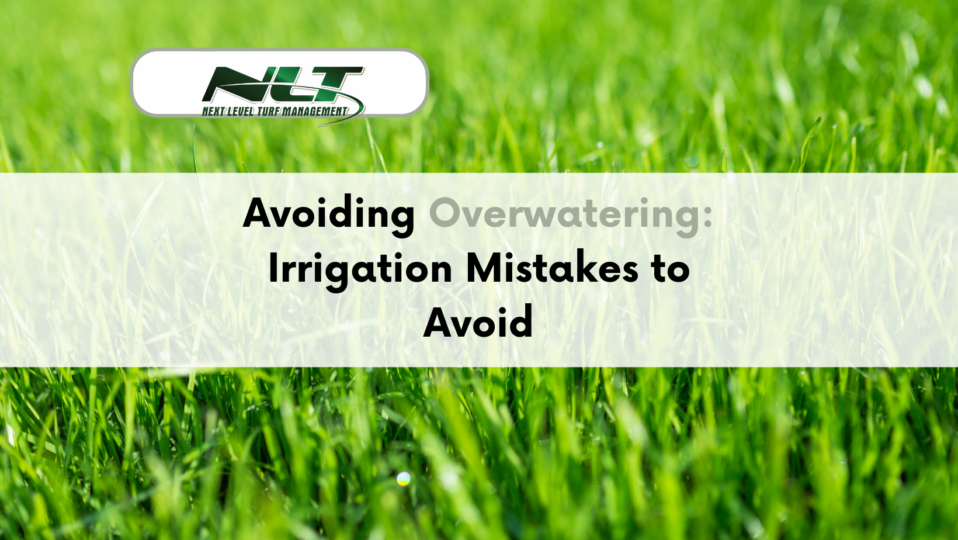 10
Dec
10
Dec
Avoiding Overwatering: Irrigation Mistakes to Avoid
Overwatering your lawn can do more harm than good. It can cause soggy patches, encourage weed growth, and lead to the development of lawn diseases. Understanding how to avoid overwatering is crucial for maintaining a healthy and lush lawn. One common mistake many homeowners make is thinking that more water means healthier grass. However, too much water can suffocate grass roots and reduce the oxygen they need to grow. Waterlogged soil is also a perfect environment for fungi and bacteria that cause lawn diseases. Improper irrigation practices can waste water and raise your utility bills. Simple changes, like knowing when and how long to water, can make a big difference. By fine-tuning your irrigation system, you can save both water and money, while ensuring your lawn gets the right amount of moisture. In this article, we’ll explore the effects of overwatering, identify common irrigation mistakes, and provide tips to optimize your system. Understanding these aspects can help you keep your lawn green and healthy without the pitfalls of overwatering. Understanding Overwatering and Its Effects Overwatering your lawn can lead to severe problems. When too much water is applied, the soil becomes waterlogged, depriving the grass roots of oxygen. Grass roots need oxygen to breathe and grow. Without it, the roots become weak and the grass starts to die. Waterlogged soil is also a perfect breeding ground for fungal diseases like root rot and mold. These diseases can spread through your lawn, killing large patches of grass. Overwatering can also cause nutrient runoff, where essential nutrients are washed away from the roots. This leaves the grass weak and less able to fend off pests and diseases. Additionally, overwatering encourages weeds to grow. Weeds like crabgrass and nutsedge thrive in soggy conditions, outcompeting your lawn for resources. This problem can quickly spiral, making your lawn look messy and unhealthy. In the long run, this can lead to higher costs for weed control and lawn repair. Understanding the negative effects of overwatering can help you become more mindful of your irrigation practices. Proper watering techniques are crucial for maintaining a lush and healthy lawn. Common Irrigation Mistakes Leading to Overwatering Several common mistakes can lead to overwatering your lawn. Knowing what these are helps you avoid them and keep your lawn healthy. Watering Too Frequently: Many people think that watering their lawn every day is good. In reality, grass roots need time to dry out between waterings. Watering too often keeps the soil too moist, encouraging shallow roots and weak grass. Watering at the Wrong Time: Watering in the middle of the day causes a lot of water to evaporate before it can soak into the soil. Watering in the evening leaves grass wet overnight, promoting fungal growth. The best time to water is early in the morning when temperatures are cooler. Using Wrong Irrigation Settings: Incorrect sprinkler settings can either provide too much or too little water. Overlapping sprinkler zones can lead to puddles while poor coverage leaves patches dry. It’s critical to adjust your system for even and appropriate water distribution. Ignoring Seasonal Changes: Watering schedules should change with the seasons. […]
-
 30
Oct
30
Oct
Revitalize Your Lawn: Late Summer Sod Installation Tips
Ready to give your lawn a fresh start? Late summer is a great time for sod installation and revitalize your yard. The warm soil and cooler weather create perfect conditions for grass roots to establish. By starting in late summer, your sod will have enough time to take root before winter arrives. Installing sod can seem like a big job, but with the right steps, it’s totally doable. From choosing the right type of sod to preparing your soil, each step is essential for a healthy lawn. The process includes laying the sod correctly, making sure it’s watered well, and keeping it free from weeds and pests. In this guide, we’ll walk you through everything you need to know about installing sod in late summer. Whether you’re a seasoned gardener or a first-time homeowner, these tips will help you achieve a lush, green lawn that makes your yard the envy of the neighborhood. Why Late Summer Is Ideal for Sod Installation Late summer offers prime conditions for installing sod. The soil is warm, which helps the sod’s roots establish quickly. This is crucial for the grass to survive and thrive before the cooler months set in. Plus, the weather starts to cool down, reducing the stress on the new sod from extreme heat. Another benefit is the likelihood of more regular rainfall in late summer. This natural watering helps keep the sod moist, which is essential for root development. With a good balance of sun and rain, late summer creates the perfect environment for sod to adapt and grow. By choosing late summer for sod installation, you give your lawn a head start. The grass has ample time to take root and strengthen before winter, leading to a healthier, more resilient lawn come spring. Choosing the Right Sod for Your Lawn Selecting the right type of sod is the first step to a successful lawn. Different grass varieties have specific needs and characteristics. Some are better suited for shady areas, while others thrive in full sun. In Central Florida, popular choices include St. Augustine, Bermuda, and Zoysia. St. Augustine grass is known for its thick, lush appearance and does well in both sun and shade. Bermuda grass is hardy and tolerates heat and traffic, making it ideal for active households. Zoysia grass is drought-resistant and grows well in different types of soil. Consider your lawn’s specific conditions, such as sunlight, soil type, and foot traffic, when deciding which sod to install. A local turf specialist can provide valuable advice on the best grass type for your area. Preparing Your Soil: First Steps Proper soil preparation is key to successful sod installation. Start by clearing the area of any debris, rocks, and old grass. This gives your new sod a clean slate to grow on. Use a shovel or sod cutter to remove the existing grass and weeds. Next, test your soil’s pH level using a soil test kit. Most grasses prefer a pH range between 6 and 7. If your soil is too acidic or alkaline, you can adjust it with lime or sulfur products. Follow the manufacturer’s instructions for […]
-
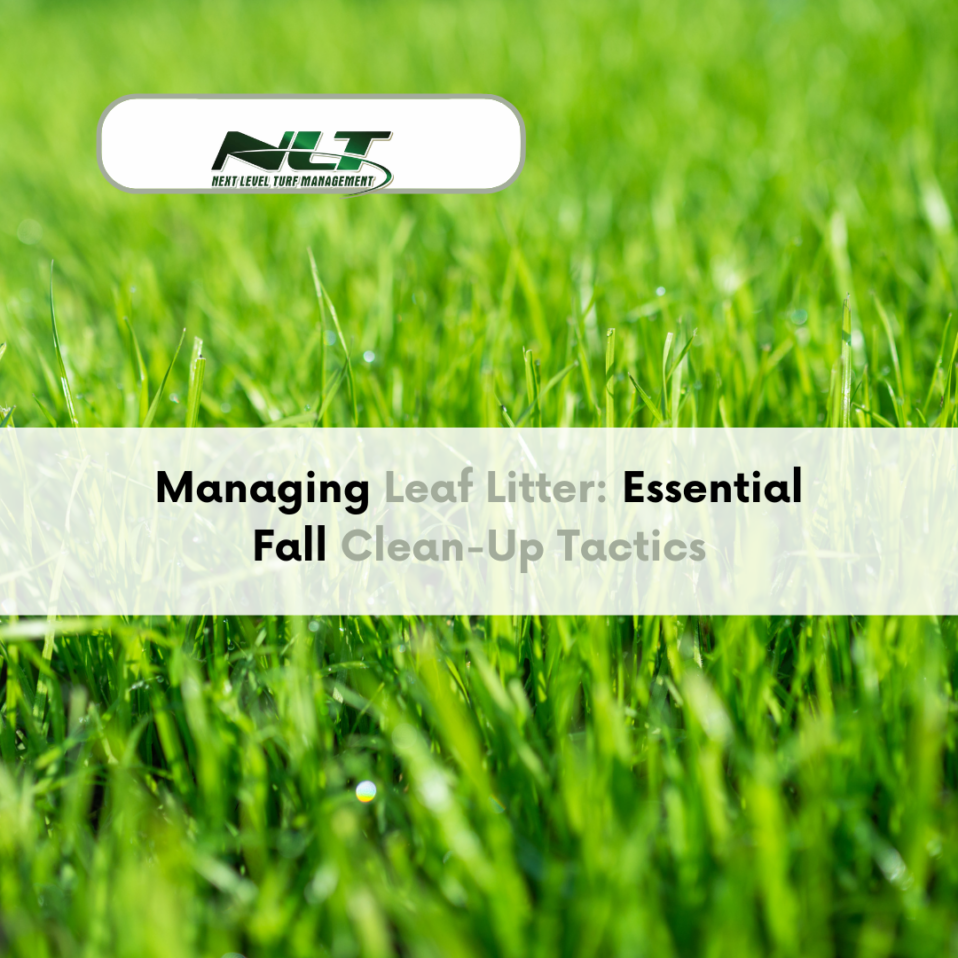 30
Oct
30
Oct
Managing Leaf Litter: Essential Fall Clean-Up Tactics
Fall brings cooler weather and beautiful colors, but it also leads to a yard full of fallen leaves. Managing leaf litter is crucial for keeping your lawn healthy and your property looking neat. If leaves are left to pile up, they can suffocate your grass, leading to dead spots and increased pests. Proper leaf cleanup ensures your lawn gets the sunlight and air it needs to thrive. Cleaning up leaves doesn’t have to be a daunting task. With the right tools and techniques, you can handle leaf litter efficiently. Whether you prefer raking, using a leaf blower, or mulching the leaves back into the lawn, there’s an approach that fits your needs. Understanding the best time to start your clean-up and knowing some handy tips can make the process smoother. In this guide, we cover the essentials of fall leaf cleanup. From choosing the right tools to learning effective raking methods, you’ll find everything you need to keep your yard leaf-free this season. Make the most of fall without the hassle of leaf clutter. Why Managing Leaf Litter Is Important Managing leaf litter is essential for several reasons. First, leaves left on your lawn can block sunlight and air from reaching the grass. This can lead to dead spots and weakened grass, making your lawn look unhealthy and patchy. Second, wet leaves can become slippery and create a hazard, especially on walkways and driveways. They can also retain moisture, creating an ideal environment for mold and mildew to grow. Lastly, a thick layer of leaves can hide potential problems such as pests or diseases. By removing leaves regularly, you maintain a healthier lawn and reduce the chances of these issues taking hold. The Best Time for Fall Clean-Up Timing your fall cleanup activities is crucial for effectiveness. Start leaf removal as soon as the leaves begin to fall. This prevents the leaves from piling up and becoming unmanageable. A good rule is to plan a more thorough cleanup once a week during peak leaf-fall season. This keeps your yard from becoming overwhelmed with leaves. If you wait too long, the leaves can get wet and heavy, making them harder to remove. Fall cleanup is best done in the late morning or early afternoon when the dew has dried. Dry leaves are lighter and easier to handle, reducing the effort needed to clear them from your yard. Essential Tools for Leaf Removal Having the right tools makes leaf removal much easier and more efficient. Here are some essential tools for the job: Rake: A good, sturdy rake is a must. Look for one with wide tines to grab more leaves with each pass. Leaf Blower: For larger areas, a leaf blower can save time and effort. Choose one with adjustable speeds to handle different tasks. Leaf Bags: Strong, durable leaf bags are needed for collecting and disposing of leaves. Tarp: A large tarp can help collect piles of leaves and make it easier to drag them to your compost pile or curb. Gloves: Use gloves to protect your hands from blisters and sharp objects hidden in the leaves. With these tools, […]
-
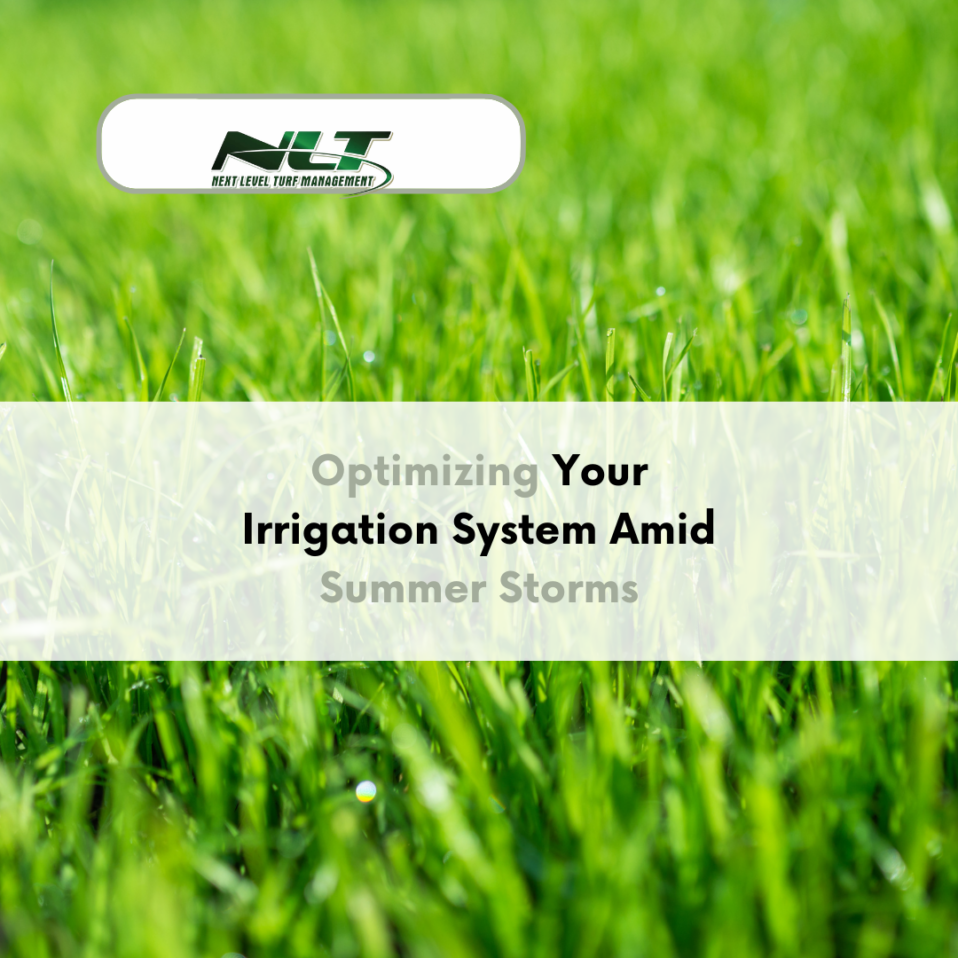 13
Sep
13
Sep
Optimizing Your Irrigation System Amid Summer Storms
Summer storms can provide much-needed rain, but they can also wreak havoc on your irrigation system. With the unpredictable weather patterns in Central Florida, it’s crucial to ensure your irrigation system operates efficiently. Too much water can be just as harmful to your lawn as too little. Understanding how to adjust your irrigation settings, clean sprinkler heads, and install useful tools can help you maintain a healthy lawn. Efficient irrigation not only conserves water but also saves you money on your utility bills. Proper maintenance and adjustments can prevent overwatering, which can lead to root rot and other lawn issues. With that in mind, we’ll cover essential tips and techniques to optimize your irrigation system during summer storms. From installing rain sensors to adjusting watering schedules, these steps will help you manage your lawn more effectively. By taking proactive measures, you can enjoy a lush, green lawn without the stress of weather-related damage. Understanding the Impact of Summer Storms on Irrigation Systems Summer storms can bring heavy rainfall, strong winds, and sometimes even lightning. All these factors can affect the way your irrigation system operates. Too much rain can lead to overwatering, which harms your lawn. Wind can misdirect sprinkler patterns, wasting water and missing key areas that need hydration. Storms can also cause debris to clog sprinkler heads and damage electronic components like timers and controllers. These issues can lead to inefficient watering and increased water bills. Knowing the potential impacts of summer storms helps you take steps to protect your irrigation system and keep it running smoothly. By understanding the effects of storms, you can better prepare your lawn and irrigation system to handle the weather. Regular maintenance and smart adjustments can save water, reduce costs, and keep your lawn healthy. Benefits of an Efficient Irrigation System An efficient irrigation system provides numerous benefits. First, it ensures your lawn gets the right amount of water, promoting healthy growth and reducing the risk of diseases. A well-maintained system also conserves water by minimizing waste, which is environmentally friendly and can lower your water bill. Efficient systems can also save you time. With features like timers and rain sensors, you don’t have to worry about manually adjusting your irrigation settings. These systems adapt to weather conditions automatically, ensuring your lawn gets the care it needs, regardless of the weather. Finally, an efficient irrigation system adds value to your property. A lush, green lawn enhances curb appeal and creates a welcoming environment. By investing in a quality irrigation setup, you improve the overall look and health of your outdoor space. Assessing Your Current Irrigation Setup Before making any improvements, it’s essential to assess your current irrigation setup. Start by checking the condition of your equipment. Look for any signs of wear and tear, such as cracked pipes, broken sprinkler heads, or leaks. Identifying these issues early allows you to fix them before they cause significant damage. Next, evaluate your watering schedule. Make sure your system is set to water your lawn at the optimal times. Early morning is usually best, as it reduces evaporation and allows the grass to dry before […]
-
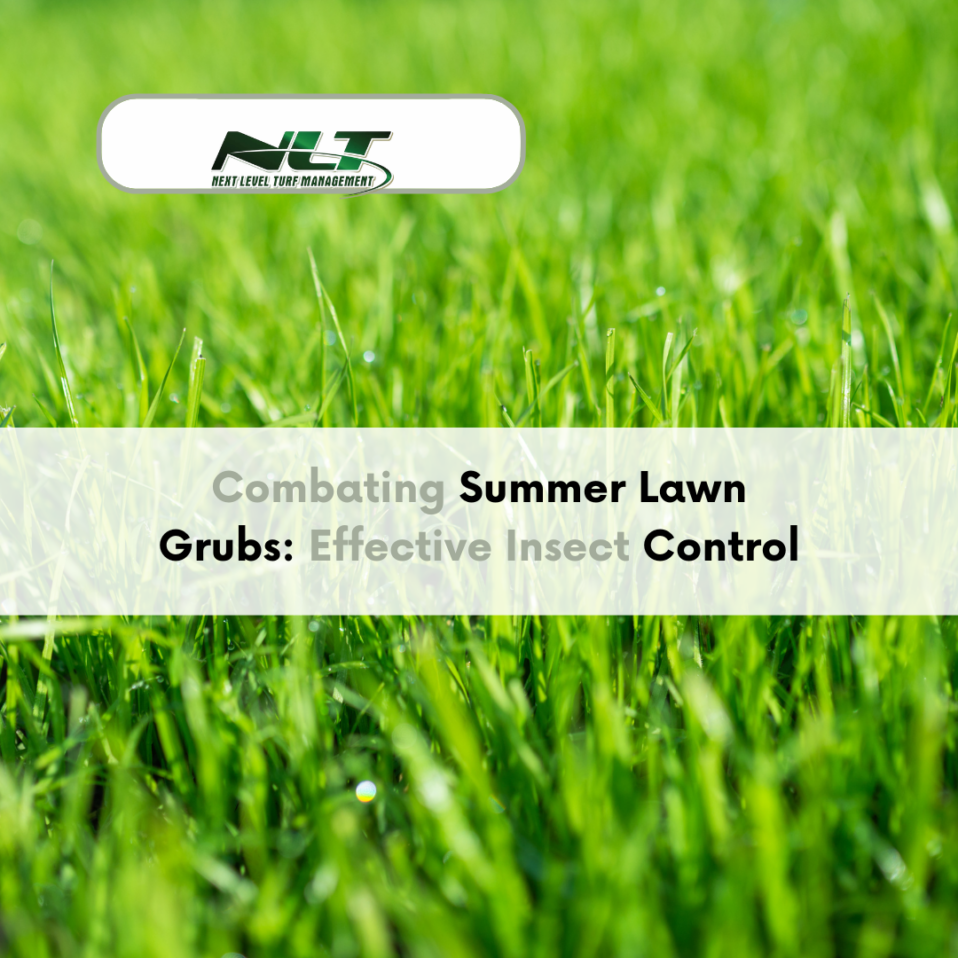 13
Sep
13
Sep
Combating Summer Lawn Grubs: Effective Insect Control
Lawn grubs can become a major headache during the summer months. These small, white larvae live in the soil and feast on the roots of grass, causing patches of dead or dying turf. It’s important to understand how to identify and control these pests to keep your lawn healthy and green. Identifying lawn grubs early can save your yard from serious damage. You might notice birds pecking at your grass or raccoons digging up your lawn. These are often signs that grubs are present. By knowing what to look for and taking action quickly, you can prevent widespread damage. Let’s explore effective methods for controlling lawn grubs in Central Florida. You’ll learn about their life cycle, natural predators, and the best times to use chemical treatments. We’ll also provide helpful tips for monitoring your lawn and restoring it after an infestation. With the right knowledge and tools, you can keep your lawn looking its best all summer long. Understanding Lawn Grubs: What Are They? Lawn grubs are the larvae of beetles, such as Japanese beetles, June bugs, and chafer beetles. These small, C-shaped insects are usually white or gray with darker tips. They live just below the surface of your grass, feeding on the roots. This feeding activity weakens the turf, making it more prone to damage. Grubs are most active in the late summer, when they are fully grown and feeding heavily. If left unchecked, they can create large dead patches in your lawn. Recognizing and controlling grubs early can prevent significant damage and maintain the health of your turf. Grubs thrive in moist, well-fertilized lawns. Their damage is most noticeable during drought periods when your grass is already stressed. By understanding what lawn grubs are and how they operate, you can take effective measures to control them and keep your lawn lush and green. Identifying Signs Of Grub Infestation Spotting a grub infestation early is crucial to managing it effectively. Here are some common signs to look for: 1. Brown or Dead Patches: Irregular patches of brown, dead grass are often a sign of grub activity below the surface. 2. Spongy Turf: Healthy grass should feel firm when you walk on it. If you notice spongy areas, this could indicate grub activity. 3. Increased Animal Activity: Animals like birds, raccoons, and skunks dig into the grass to feed on grubs. They can leave noticeable holes in your yard. 4. Easy-To-Pull Grass: If your grass pulls up easily when you tug on it, revealing C-shaped grubs underneath, you have an infestation. 5. Visible Grubs: Digging up a small section of your lawn can reveal the presence of grubs if they are indeed the cause of your lawn problems. If you notice any of these signs, it’s time to take action and address the grub problem before it becomes a more significant issue. Common Types Of Lawn Grubs Found In Central Florida Central Florida is home to several types of lawn grubs. Understanding which ones are in your area can help you identify and control them more effectively. 1. Japanese Beetle Grubs: These are the larvae of the Japanese beetle, […]
-
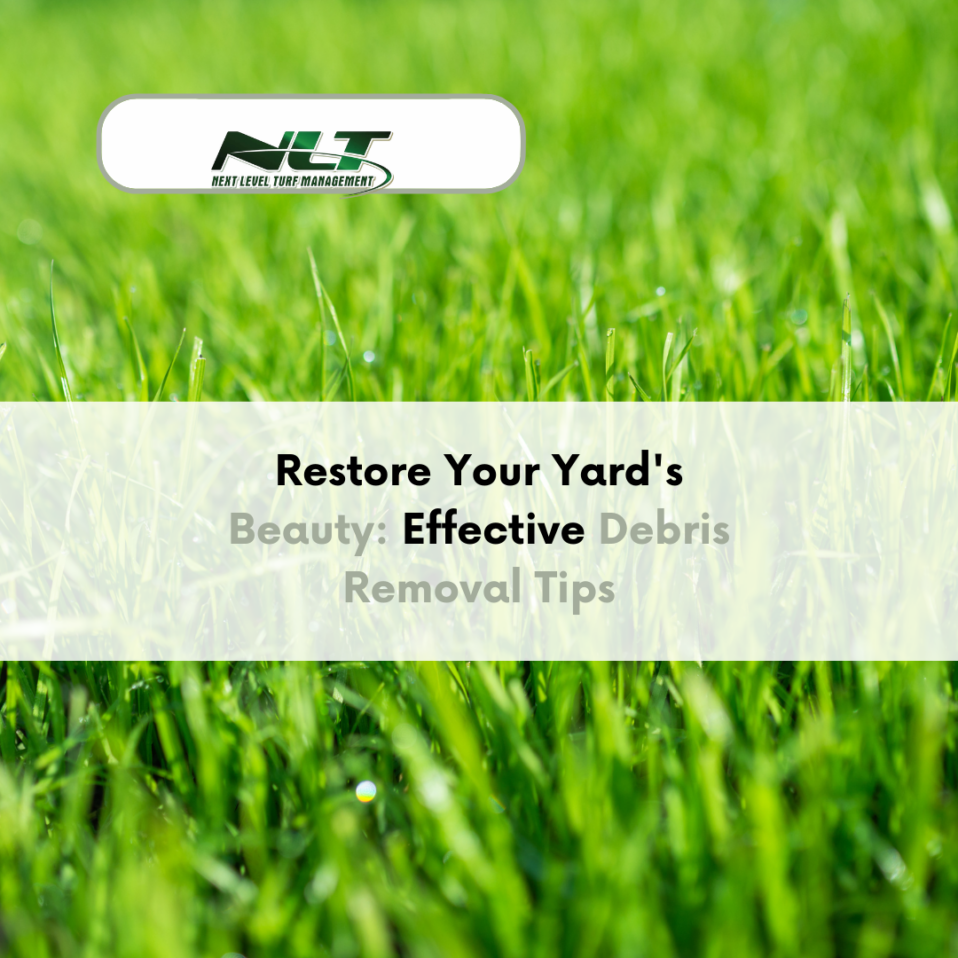 11
Aug
11
Aug
Restore Your Yard’s Beauty: Effective Debris Removal Tips
Summer is a wonderful time to enjoy your lawn, but it’s also when debris can accumulate, making your outdoor space look untidy. Leaves, branches, and other debris can hinder your lawn’s beauty and health. Properly managing this debris is crucial to maintaining a vibrant, welcoming yard. Tackling stubborn debris requires a combination of the right tools, techniques, and a bit of persistence. Central Florida, with its unique climate and frequent storms, often leaves homeowners dealing with more than their fair share of lawn debris. From fallen leaves to broken branches, it’s essential to keep your lawn clear to prevent damage and ensure it looks its best throughout the season. Additionally, accumulated debris can create ideal conditions for pests and diseases, further stressing your lawn. Our aim is to provide you with effective summer clean-up solutions that can help you manage and eliminate stubborn debris. By following expert advice from Central Florida’s premier turf management company, you can keep your lawn in top shape all summer long. We will cover essential clean-up tips, the best tools to use, and how to dispose of debris properly. With these practical solutions, you’ll be better equipped to handle any debris the season throws your way. Let’s dive into how to tackle stubborn debris and maintain a pristine, healthy lawn throughout the summer months! Identifying Common Summer Debris Summer brings a lot of debris to your yard. Identifying the types of debris can help you choose the best clean-up methods. Fallen Leaves: Even in summer, some trees shed leaves. Fallen leaves can quickly cover your lawn, blocking sunlight and air from reaching the grass. Regularly raking or blowing leaves helps keep your lawn healthy. Branches and Twigs: Storms and wind can scatter branches and twigs across your yard. Larger branches need to be removed promptly to prevent damage to your grass and garden. Smaller twigs can also cause problems, so it’s best to collect them regularly. Weeds: Weeds grow fast in warm weather. They compete with your grass for sunlight, water, and nutrients. Regularly pulling weeds or using safe weed control products keeps them in check and prevents them from overtaking your lawn. Essential Tools for Effective Debris Removal Having the right tools makes summer clean-up faster and easier. Here are some must-have items for debris removal:. Rakes: A sturdy rake is essential for gathering leaves and small debris. Choose one with flexible tines to prevent damaging your grass. Leaf Blowers: Leaf blowers are useful for moving large amounts of leaves quickly. They come in various sizes and styles, so select one that fits your yard’s needs and your comfort level. Wheelbarrows: A wheelbarrow helps transport large piles of leaves, branches, and other debris to your disposal area. This tool saves time and effort, especially if you have a big yard. Gloves: Protect your hands from sharp twigs and rough branches by wearing good-quality gloves. They also keep your hands clean and help you grip tools better. Pruners: Pruners are useful for cutting back small branches and trimming shrubs. Keeping your plants trimmed reduces the amount of debris that falls to the ground. Techniques for […]
-
 11
Aug
11
Aug
Achieve a Perfect Lawn: Signs You Need to Replace Your Grass
A lush, green lawn is a vital part of any beautiful home, providing a welcoming space for relaxation and outdoor activities. In Central Florida, maintaining a healthy lawn can be a challenge due to the region’s unique climate and soil conditions. Over time, various factors such as pests, diseases, and harsh weather can take a toll on your grass, leaving it looking worn out and unhealthy. When this happens, it might be time to consider laying new sod. As Central Florida’s premier turf management company, Next Level Turf understands the importance of recognizing when your lawn needs a fresh start. Let’s explore the critical signs that indicate your lawn requires new sod. We’ll provide expert evaluation tips to help you assess the condition of your grass accurately. From persistent bare patches to unusual discoloration, we’ll cover all the essential aspects you need to consider before making this important decision. Replacing sod isn’t just about aesthetics; it’s also crucial for the overall health and sustainability of your lawn. By paying attention to these signs, you can ensure your outdoor space remains vibrant and robust. Whether you’re a seasoned gardener or a new homeowner, understanding when to replace sod will save you time, money, and effort in the long run. So, let’s dive into the essential indicators that your lawn may need new sod and how you can address these issues effectively. Persistent Bare Patches One of the most obvious signs that your lawn may need new sod is the presence of persistent bare patches. Bare spots in your grass can occur for various reasons, including heavy foot traffic, pest infestations, and soil compaction. While small bare patches can sometimes be resolved with proper lawn care practices, larger or recurring patches signal more serious problems. Heavy Foot Traffic: Areas with high foot traffic, like pathways or play areas, often develop bare spots as the grass gets worn down. Grass recovery in these areas can be challenging and may require new sod to restore full coverage. Pest Infestations: Pests like grubs and sod webworms feed on grass roots, causing sections of your lawn to die and create bare patches. If you notice birds pecking at your lawn or if the affected areas can be easily lifted, you might have a pest problem that new sod can help correct. Soil Compaction: Compacted soil restricts root growth and water absorption, leading to bare spots. Aerating the soil may help in minor cases, but if the problem persists, laying new sod is often the best solution. Unusual Discoloration Another key indicator that your lawn may need new sod is unusual discoloration that does not improve with standard care practices. Discoloration can be caused by poor soil quality, diseases, or heat stress, and understanding what’s affecting your lawn is crucial. Poor Soil Quality: Soil that lacks essential nutrients will support weak and discolored grass. Conducting a soil test can reveal deficiencies, and while fertilizers might offer temporary relief, new sod will ensure long-term health and uniform color. Grass Diseases: Various diseases can cause discoloration, including fungal infections like brown patch and dollar spot. Diseased grass often has […]
-
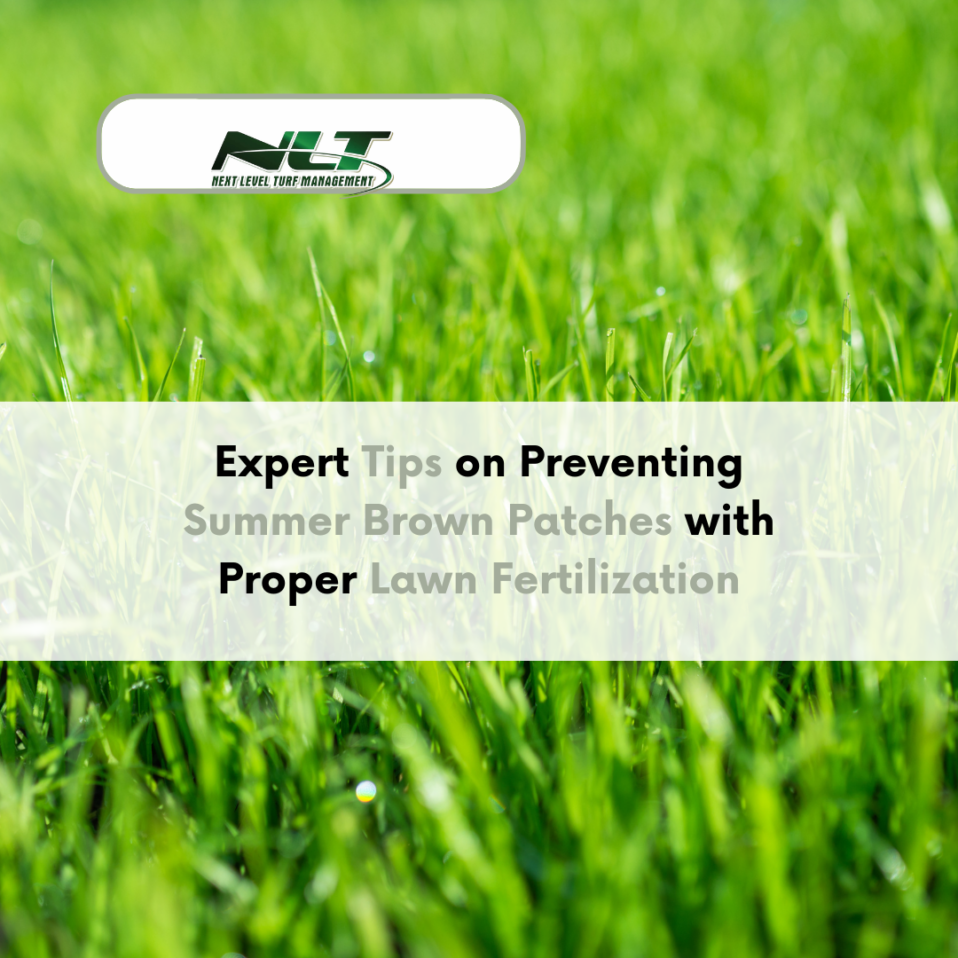 02
Jul
02
Jul
Expert Tips on Preventing Summer Brown Patches with Proper Lawn Fertilization
Summer in Central Florida brings not only warm, sunny days but also the potential for unsightly brown patches on your otherwise pristine lawn. These patches can appear seemingly overnight and can quickly spread, turning your lush green grass into a patchy, brown eyesore. Understanding the root causes and implementing effective prevention strategies is key to maintaining a healthy, vibrant lawn throughout the summer months. In this article, we will delve into the various causes of summer brown patches and offer expert tips on using fertilization to combat and prevent them. Whether you’re a seasoned lawn care enthusiast or a new homeowner looking to maintain your yard, these insights will equip you with the knowledge and tools needed to keep your lawn looking its best all summer. Join us as we explore the science and art of effective lawn fertilization and learn how to protect your grass from the dreaded summer brown patches. Understanding Brown Patches Brown patches on lawns are caused by various factors, including fungal diseases, improper watering, and nutrient imbalances. These patches are most common during summer due to the heat and humidity that create an ideal environment for fungi. Identifying the specific cause of brown patches on your lawn is crucial for effective treatment and prevention. Identifying Fungal Diseases Fungal diseases are a primary cause of brown patches. One common disease is brown patch fungus, which thrives in warm, humid conditions. You’ll notice circular brown spots with a darker ring around the edges. Other fungi include dollar spots and leaf spots, which also cause discoloration and dead patches. To confirm a fungal issue, inspect your grass closely. Look for symptoms like wilting, thinning, or specific patterns of browning. It’s essential to address fungal diseases quickly to prevent them from spreading across your lawn. Proper Watering Techniques Improper watering can lead to brown patches. Too much or too little water stresses the grass, making it susceptible to diseases and pests. In Central Florida’s summer, maintaining an optimal watering schedule is crucial. Aim to water your lawn early in the morning. This allows the grass to absorb moisture before the heat of the day and prevents the growth of fungi that thrive in wet, dark conditions. Ensure your lawn receives about 1 inch of water per week, adjusting for rainfall. Nutrient Imbalance and Fertilization A lack of essential nutrients can weaken your grass, making it more prone to brown patches. Fertilization provides necessary nutrients that promote healthy growth and resilience. A balanced fertilizer containing nitrogen, phosphorus, and potassium will support your lawn’s overall health. Apply fertilizer at the correct times throughout the year. In Central Florida, this typically means fertilizing in early spring and late summer. Follow the instructions on the fertilizer package to avoid over-fertilizing, which can harm your grass. Aeration and Soil Health Compacted soil restricts the flow of air, water, and nutrients to your grass roots. This can lead to brown patches as the grass struggles to grow in poor conditions. Aeration involves perforating the soil with small holes to allow air, water, and nutrients to penetrate the roots more effectively. Aerate your lawn at least […]
-
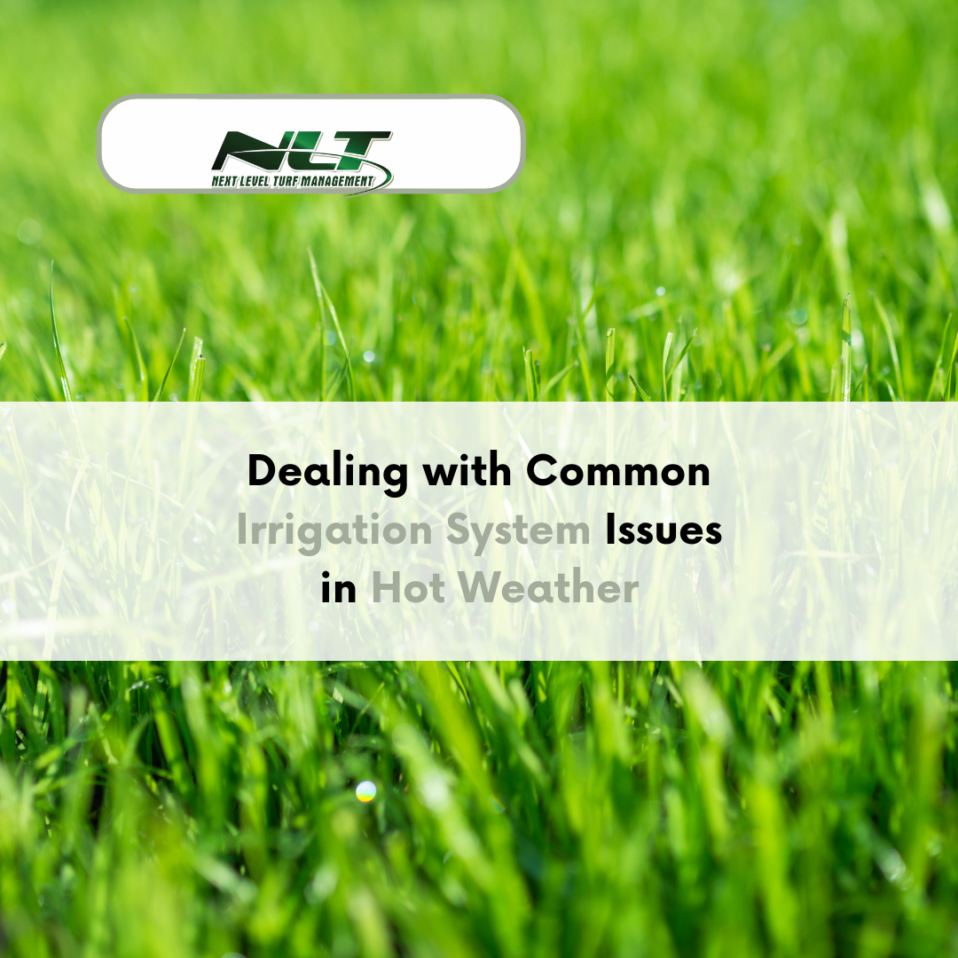 02
Jul
02
Jul
Dealing with Common Irrigation System Issues in Hot Weather
In the scorching heat of Central Florida, maintaining a lush, green lawn can be a challenge. An irrigation system is essential for keeping your grass healthy and providing the necessary moisture it needs, especially during hot weather. However, hot temperatures can cause various problems in irrigation systems, impacting their efficiency and effectiveness. This article will explore common irrigation system issues that arise in hot weather and offer practical solutions to keep your lawn looking its best. Clogged Sprinkler Heads In hot weather, debris such as dirt, grass clippings, and small stones can easily clog sprinkler heads. This blockage prevents water from spraying evenly, leading to dry patches on your lawn. Clogged sprinkler heads can also cause water to pool around the base, which wastes water and can damage your grass. Identifying Clogs: Regularly inspect your sprinkler heads. If you notice uneven water distribution, weak spray patterns, or no water coming out at all, the head may be clogged. Turn off the system, remove the sprinkler head, and clean it with water and a small brush. Preventive Measures: To prevent clogs, consider adding a filter to your irrigation system. Regularly check and clean the sprinkler heads to ensure they remain free of debris. Keeping your lawn free of excessive grass clippings and debris also helps reduce the risk of clogs. Timing Problems Timing is crucial when it comes to watering your lawn. In hot weather, your lawn needs more water to stay healthy, but incorrect timing can lead to waste and inefficient watering. Overwatering can cause fungal diseases, while underwatering can leave your lawn brown and dry. Best Time to Water: The best time to water your lawn is early in the morning. This allows the grass to absorb the moisture before the heat of the day causes evaporation. Avoid watering in the evening, as this can promote fungal growth due to prolonged moisture. Setting Timers: Ensure your irrigation system’s timer is set correctly. Regularly check the settings and adjust them according to seasonal changes. During extremely hot periods, you might need to increase watering frequency slightly. Monitoring local weather forecasts can help you make informed decisions about when to water. Leaks and Broken Pipes Leaks and broken pipes in your irrigation system can cause significant water waste, higher utility bills, and uneven watering, leading to brown spots on your lawn. Hot weather can exacerbate these problems, making timely repairs essential. Detecting Leaks: Regularly check your irrigation system for signs of leaks. Look for unusually wet areas in your lawn, low water pressure, or water pooling around sprinkler heads. Checking your water meter before and after a no-use period can also help identify potential leaks. Fixing Broken Pipes: If you find a leak or broken pipe, turn off the water supply to the affected section. Dig carefully around the pipe to expose it, then cut out the damaged section and replace it with a new piece of pipe. Use appropriate connectors to ensure a watertight seal. Pressure Issues Water pressure problems can affect the efficiency of your irrigation system. Low pressure may not deliver enough water to all areas of your […]
-
 31
May
31
May
Understanding Weed Management Challenges in Florida’s Warm Climates
In the lush, varied landscapes of Florida, maintaining a weed-free lawn presents a set of unique challenges. The state’s warm, humid climate not only encourages the vigorous growth of turfgrass but also fosters a thriving environment for a wide array of weed species. For homeowners and garden enthusiasts, effective weed management is crucial to ensure that their lawns remain both aesthetically pleasing and functionally robust. At Next Level Turf, located in the heart of Central Florida, we understand the complexities and challenges of weed control specific to this region. The persistent warmth provides a nearly year-round growing season, not only for the grasses we cherish but also for invasive weeds that can quickly overtake a lawn if not appropriately managed. These challenges are compounded by Florida’s frequent rains and the adaptability of weeds to the local conditions, making traditional weed control measures less effective. This article aims to shed light on the specific hurdles faced by those managing turf in Florida’s warm climates and to offer insights and expert techniques developed by Next Level Turf for combating these persistent invaders. Whether you are new to lawn care or a seasoned gardener facing persistent weed issues, understanding these challenges is the first step toward achieving a lush, healthy lawn free of unwanted plants. Join us as we delve into effective strategies tailored to keep your turf in excellent condition, reflecting the beauty and vitality of Florida’s natural landscape. Rapid Weed Growth Due to Warm Temperatures One of the primary challenges in managing a lawn in Florida is the rapid growth rate of weeds fueled by the state’s warm temperatures. Weeds such as crabgrass, dollarweed, and nutsedge thrive in warm environments and can quickly become problematic. These invasive species are aggressive growers, thriving on the abundant sunlight and moisture that characterize Florida’s climate. Because they grow faster than many types of turfgrass, they can swiftly overtake a lawn if not regularly monitored and managed. High Humidity and Moisture Levels Florida’s high humidity and frequent rainfall create an ideal environment for many weed types. Excessive moisture promotes the proliferation of weeds, especially those that thrive in damp conditions, like sedges and mosses. These conditions can be challenging to control because they require different strategies than those needed for drier climates or less aggressive weeds. For example, while some regions might benefit from reduced watering to control weed growth, Florida’s natural humidity and precipitation make such tactics impractical. Weed Adaptability The adaptability of weeds in Florida presents another significant challenge for homeowners. Many weeds have developed resistance to common herbicides, making chemical control methods less effective over time. Furthermore, these resilient species are often able to survive in a variety of soil types and pH levels, adapting quickly to changes in their environment. This adaptability means that Florida gardeners must be vigilant and possibly employ a combination of cultural, mechanical, and chemical weed management strategies to keep their lawns healthy. Integration of Effective Weed Management Practices Effective weed management in warm Florida climates must integrate various approaches to prevent and mitigate weed invasions. This includes: Proper Fertilization: A well-fertilized lawn promotes healthy grass growth […]
-
 31
May
31
May
Essential Care Tips for New Sod in the First Weeks
Installing new sod is an exciting step towards achieving a lush, vibrant lawn that enhances the beauty of your home. However, the success of sod installation depends significantly on the care it receives during the first few weeks post-installation. In the unique climate of Central Florida, where the weather can be particularly harsh on new turf, understanding the right care techniques is crucial. Proper maintenance during this initial period can ensure your new sod develops deep roots and transitions smoothly into a healthy, resilient lawn. At Next Level Turf, we specialize in transforming landscapes with high-quality sod suited to the Florida climate and providing the expert care needed to establish these new lawns. The first few weeks are critical as the sod begins to integrate with the soil in its new environment. Watering, mowing, and monitoring for pests and diseases during this time are key to preventing issues that could compromise the lawn’s health and longevity. In this article, we’ll guide you through the comprehensive steps on how to care for your new sod during these vital initial weeks. From the installation day to the critical moments of root establishment, we’ll cover everything you need to know to nurture your new lawn toward optimal growth and sustainability. Whether you are a new homeowner or looking to refurbish your landscape, these insights will equip you with the knowledge to maintain a vibrant and thriving sodded lawn. Initial Watering: The Foundation of Sod Care After your new sod is laid down, watering becomes the most critical task. During the first week, the goal is to keep the sod and the soil beneath it thoroughly moistened but not overly soaked. You should start watering your new sod within 30 minutes of installation to prevent it from drying out and shrinking. For the first seven days, water the sod at least twice a day—early in the morning and late in the afternoon. This ensures the sod doesn’t sit too wet overnight, which can encourage disease. Applying about ½ inch of water each session is usually sufficient to penetrate the sod and slightly moisten the top inch of the underlying soil. Use a screwdriver or similar tool to check the moisture level. If it slides in easily up to 6-7 inches deep, you’re watering enough; if not, you need to increase your watering time slightly. Mowing Your New Sod The first mowing typically occurs within 10 to 14 days post-installation, depending on grass type and growth rate, which accelerates with good watering practices. The key to the first mow is to ensure the sod has rooted sufficiently so it won’t pull up when mowed. A simple test is to tug on the sod gently; if it feels anchored, it’s usually safe to mow. Set your mower to the highest setting to avoid cutting the grass too short. Cutting new sod too short can stress the grass, making it more susceptible to disease and less able to combat weeds. Mow only the top third of the grass blades, a practice that encourages deeper root growth and denser turf, which naturally chokes out potential weeds. Managing Foot […]
-
Cicadas Are Coming: How to Prepare Your Garden
Hey, Central Florida! Something big is buzzing our way in 2024—the Cicada Super Bloom. This isn’t just any bug visit; it’s a rare event when two different groups of cicadas, which we usually see every 13 and 17 years, decide to show up at the same time! Imagine, this mix-up happens only once every couple of hundred years, making it a special moment for us all to witness. Now, while cicadas might sound scary with their loud buzzing and their large numbers, they’re not here to harm our gardens. They just come up to say hello, mate, and go back into the ground. However, they do lay eggs in the branches of our trees, and that can sound a bit worrying. But don’t fret; there are straightforward steps we can all take to keep our gardens looking great. We’ll share some simple tips on how you can prepare your garden so when the cicadas come, you’ll be ready to protect your green friends without breaking a sweat. From securing the yard boundaries to checking on your watering schedules, we’ll make sure you have all the info you need to handle this natural spectacle like a pro! What’s Happening with the Cicadas in 2024? In 2024, we’re about to witness a truly unique event—the Cicada Super Bloom. This happens when two different groups of cicadas, which usually emerge every 13 and 17 years, come out at the same time. This is something you might see only once or twice in a lifetime because it happens about every 200 years! When this occurs, a huge number of cicadas will surface from underground all across many parts of the Eastern United States. They come up, make a lot of noise, and are pretty noticeable with their unique buzzing sounds. It may seem a bit overwhelming, but remember, they’re not harmful; they’re just part of a fascinating natural cycle. And while they might be loud, they’re a critical piece of our natural environment, helping us understand more about nature’s timelines and ecosystems. Simple Tips to Prepare Your Garden Preparing your garden for the arrival of cicadas is straightforward and worth the effort. Here are some simple steps we can all take: Check and Secure Your Boundaries: First things first, let’s check the fences or garden boundaries. Ensure there are no significant gaps where unwanted critters could enter. Secure any loose parts that might be damaged by the increased activity around your yard. Clear Dead Plant Material: Cicadas are attracted to decaying organic matter because it’s a great place for laying eggs. By cleaning up any dead branches, fallen leaves, or plant clutter, you make your garden less attractive for cicadas to settle in. Adjust Your Watering Schedule: During the cicada season, you might want to tweak how and when you water your garden. Cicadas typically come out when it’s warm, and they can dry out the soil around plants. Make sure you water your plants deeply and less frequently to encourage strong, deep root growth, making it harder for cicadas to disturb your plants. By following these tips, we make our gardens less inviting […]
-
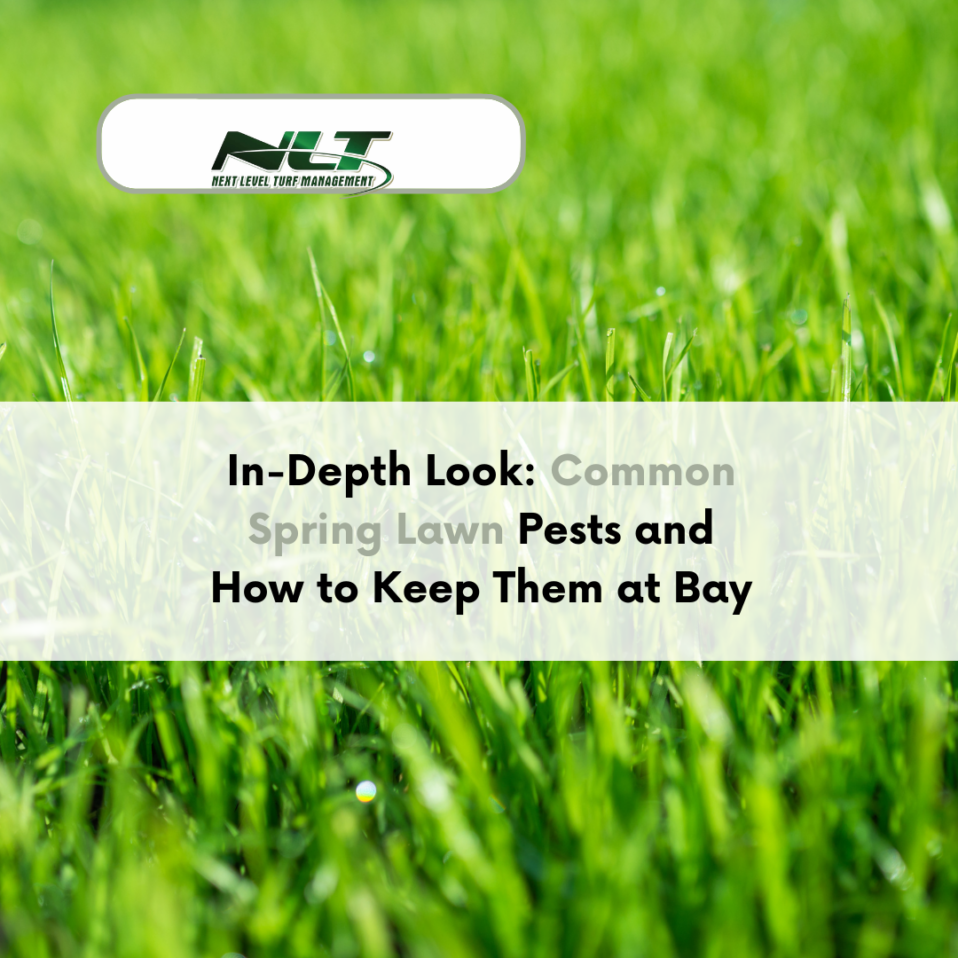 30
Apr
30
Apr
In-Depth Look: Common Spring Lawn Pests and How to Keep Them at Bay
Embrace a Pest-Free Spring Lawn with Central Florida’s Premier Turf Management Company As the signs of winter fade and spring burst forth, homeowners in Central Florida eagerly anticipate the return of greenery and the revival of their yards. However, the onset of spring also ushers in a new battle against a familiar foe: lawn pests. From munching caterpillars to tunneling mole crickets, these creatures can wreak havoc on even the most well-maintained lawns. While some lawn pests are merely an eyesore, others pose significant threats to the health and integrity of your turf, potentially causing lasting damage if left unchecked. Thankfully, Central Florida’s premier turf management company, Next Level Turf, is here to help. In this comprehensive guide, we’ll explore the most common spring lawn pests in Central Florida and provide valuable insights into effectively keeping these unwelcome invaders at bay. Equipped with this knowledge, you can protect your lush lawn from pest-induced damage, ensuring a harmonious and thriving outdoor space for your family to enjoy all season long. Join us as we dive into the world of spring lawn pests and let Next Level Turf guide you through the process of protecting your lawn from these destructive intruders, paving the way for a healthier, more beautiful, and inviting landscape this season. Identifying Common Spring Lawn Pests in Central Florida Before diving into strategies for preventing lawn pests, it is crucial to understand the common culprits that plague Central Florida’s yards during the spring season. Each pest has its own unique characteristics, habits, and life cycle, so accurately identifying them enables targeted and effective control methods. Some of the most common lawn pests in the region include: Chinch Bugs: These small, black insects are notorious for the damage they inflict on St. Augustine grass, which is prevalent in Central Florida. Chinch bugs feed on the grass by extracting plant sap, causing yellowing and death of the turf. Their swift reproduction and ability to develop resistance to pesticides make them a formidable adversary for homeowners striving to maintain a healthy lawn. Mole Crickets: These burrowing insects tunnel through the soil, creating air pockets that weaken the grassroots while promoting weed growth. Underneath their crisp brown exterior, they have unique, mole-like front limbs specialized for digging. Mole crickets can uproot plants and seedlings by feeding on roots in large numbers, causing extensive lawn damage within a short period. Sod Webworms: Sod webworms, or lawn caterpillars, are the larval stage of small brown moths. They are notoriously voracious feeders, consuming grass blades while hiding during the day and emerging at night to forage. Infestations can lead to severe defoliation and unsightly patches on lawns, with Bermudagrass, St. Augustine, and Zoysiagrass among their favorite targets. Armyworms: Another caterpillar species, armyworms, feed on grass surfaces and tender foliage. These green or gray caterpillars move in large groups, consuming vast expanses of grass in a short time, hence their name. An unchecked armyworm infestation can leave a lawn looking as if it has been mowed too short, stunting growth and leaving it susceptible to further damage by other pests or diseases. Proactive Inspection for Early Pest […]
-
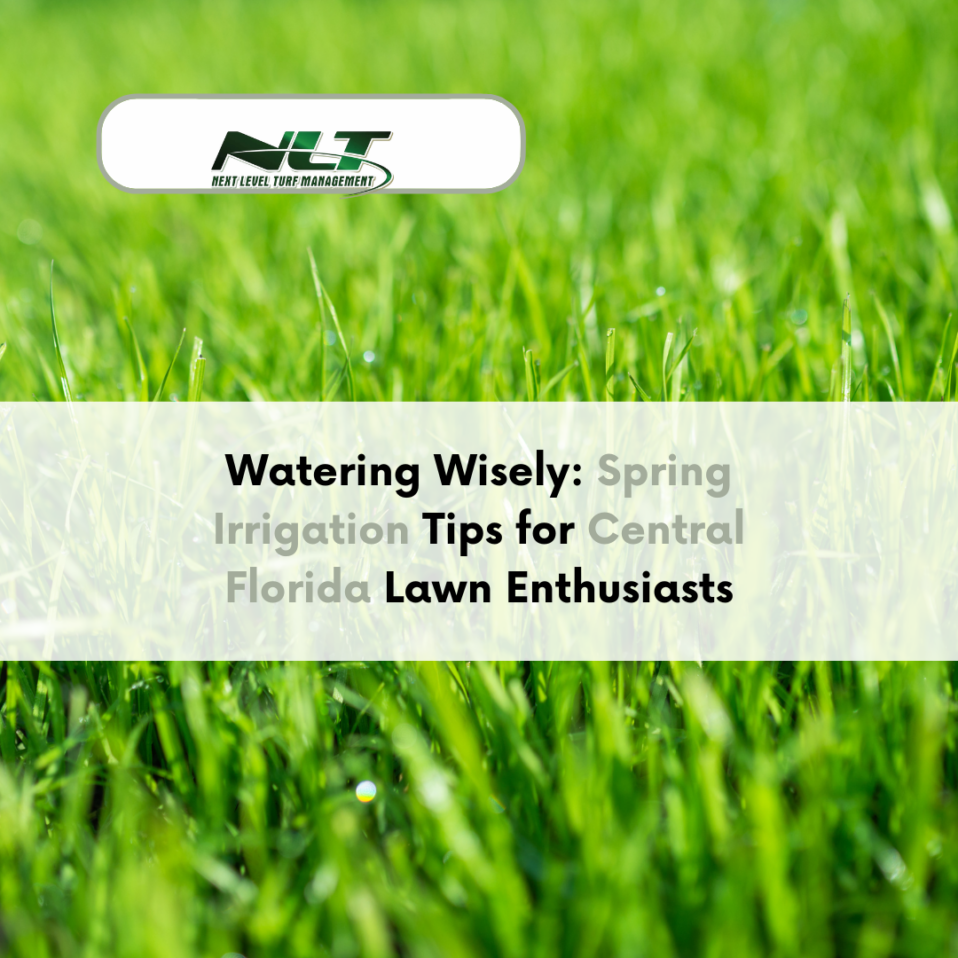 30
Apr
30
Apr
Watering Wisely: Spring Irrigation Tips for Central Florida Lawn Enthusiasts
As a Central Florida homeowner, creating a lush, green lawn is a source of pride and a hallmark of a well-maintained property. But, in a region where water conservation is a crucial consideration, striking the right balance between irrigation needs and sustainable water usage can be challenging. This is where Next Level Turf, Central Florida’s Premier Turf Management Company, provides valuable guidance and support. Today, we’ll share essential tips and best practices to maintain a thriving lawn while conserving water resources. We’ll dive into optimizing your irrigation system and the benefits of partnering with professional lawn care and irrigation service providers like Next Level Turf. As spring rolls in, it’s the perfect time to reassess your lawn care and irrigation practices and adapt them to the unique challenges of Central Florida’s climate. Armed with the knowledge and strategies laid out in this guide, you can confidently tackle your landscape’s watering needs while responsibly preserving valuable water resources. So, let’s get started on your journey to a more sustainable and beautiful lawn by exploring the expert spring irrigation tips and best practices provided by Next Level Turf, the leading authority in Central Florida turf management. Understanding Central Florida’s Unique Watering Needs To develop an effective watering strategy for your Central Florida lawn in the spring, it’s essential first to understand the unique environmental factors affecting the region. Central Florida’s climate, characterized by hot temperatures and frequent rainstorms during the warmer months, makes water management critical for homeowners seeking to maintain a healthy lawn. Some key factors to consider include: Evapotranspiration Rate: The evapotranspiration rate, or the rate at which water is transferred from the land to the atmosphere through evaporation and plant transpiration, is an essential factor in determining irrigation needs. To effectively water your lawn, you must replace the moisture lost through evapotranspiration. For Central Florida, this rate tends to be higher due to the area’s warm temperatures and humid conditions. Soil Type: Central Florida soils are predominantly sandy, which means they drain water more quickly than clay or loamy soils found in other regions. Understanding this characteristic is critical when determining appropriate watering frequency and duration to prevent over- or under-watering. Seasonal Rainfall Patterns: Central Florida experiences regular rainfall throughout the spring and summer months, which can significantly impact your irrigation schedule. It’s crucial to account for natural precipitation levels to avoid wasting water and potentially harming your lawn through overwatering. Weather monitoring tools and devices can assist in making informed decisions about adjusting your watering schedule based on rainfall patterns. Creating an Efficient Irrigation System Optimizing your irrigation system for maximum water efficiency is an essential component of responsible lawn care in Central Florida. The following steps will help you create and maintain an irrigation system that minimizes water waste while effectively nurturing your lawn: Choose an Appropriate Sprinkler System: Selecting the right sprinkler system can significantly influence the overall efficiency and effectiveness of your irrigation. Drip and soaker hose systems are useful for conserving water by applying it directly to plant roots while decreasing evaporation. For lawns, using a combination of rotors and spray heads (matched precipitation […]
-
 08
Apr
08
Apr
The Advantages of Choosing Experts for a Healthy Lawn
A well-maintained lawn is an integral part of a stunning landscape, adding curb appeal, and enhancing the overall value of your property. Achieving this perfect lawn requires expertise, commitment, and proper turf management practices that only experienced professionals can consistently provide. Central Florida’s premier turf management company, Next Level Turf, is your ideal partner when it comes to transforming your lawn and ensuring it stays healthy and beautiful year-round. In this comprehensive guide, we’ll delve into the advantages of choosing experts for your lawn care needs, from their deep knowledge and experience to their ability to tailor services specific to your landscape’s unique requirements. We’ll also explore essential turf management services such as sod replacement, irrigation, environmentally-friendly practices, and ongoing lawn care support, and how they contribute to the overall health and beauty of your lawn. Finally, we’ll share insights into why Next Level Turf is the go-to choice for homeowners, property managers, and commercial businesses throughout Central Florida, seeking to create and maintain the perfect lawn. Comprehensive Knowledge and Experience to Tackle Turf Challenges One of the most significant advantages of choosing experts for a healthy lawn is their extensive knowledge and experience in diagnosing and addressing common turf challenges. From soil conditions and drainage problems to pest and disease management, professional turf care providers have seen it all and can proactively anticipate and treat potential issues. Their deep understanding of local climate, geography, and grass species enables them to provide tailored solutions that specifically cater to your landscape’s unique requirements. Accurate Soil Assessment: Professionals know the importance of proper soil assessment, testing for pH levels, compaction, and nutrient content. By accurately analyzing your lawn’s soil condition, they can recommend the best course of action, whether it’s amending, aerating or simply adjusting your maintenance routine. Climate and Grass Variety Considerations: Expert lawn care providers, being familiar with the local climate, can advise you on the best grass varieties for your area. In Central Florida, for example, warm-season grasses such as St. Augustine, Bermuda, and Zoysia are preferable. These specialists can help you select the right species for your specific needs and environmental conditions. Pest and Disease Management: Lawn care experts have a deep understanding of how to identify and treat various pest and disease issues that can plague your lawn. They’re knowledgeable in both preventive measures and curative treatments, deploying targeted interventions to maintain the overall health of your lawn with minimal environmental impact. Tailored Services to Meet Your Lawn’s Unique Needs A one-size-fits-all approach to lawn care simply doesn’t work, as every landscape has its own unique challenges and requirements. Expert turf management providers recognize this and are committed to listening to your goals and understanding your property’s specific needs. They can develop a tailored lawn care plan that optimizes the health and appearance of your turf while taking into consideration factors like water usage, maintenance requirements, and budget constraints. Custom Fertilization Programs: Knowing when and how much to fertilize your lawn requires expertise. A professional lawn care provider will design a custom fertilization program that addresses the specific needs of your turf, employing the appropriate frequency and […]
-
 08
Apr
08
Apr
Embarking on a Lawn Makeover: Key Factors to Consider When Planning Sod Replacement
A stunning, healthy lawn is the cornerstone of an attractive and welcoming property. Homeowners and property managers alike understand the importance of a well-maintained outdoor space, particularly in the beautiful region of Central Florida. As the area’s premier turf management company, we offer an array of expert services tailored to meet the specific needs of your landscape, including sod replacement. Embarking on a lawn makeover can be daunting, but with our team of professionals by your side, you’ll possess the knowledge and guidance necessary to achieve your dream yard. In this article, we’ll discuss the key factors to consider when planning a sod replacement, from choosing the right variety of grass to understanding the optimal timeline and conditions for installation. By being aware of these essential elements, you can make informed decisions that contribute to the long-term health, vitality, and beauty of your lawn. Assessing Your Lawn’s Current Condition Before embarking on a sod replacement project, it’s crucial to assess the condition of your lawn and identify any underlying issues that may impact the success of your new sod installation. A thorough examination can reveal problems such as soil compaction, pests, diseases, or poor drainage, which should be addressed prior to sod replacement. By diagnosing and resolving these challenges early on, you’ll lay the groundwork for healthy, long-lasting sod. Soil Quality: Conduct a soil test to determine the nutrient levels and pH balance in your soil. This information will help you select the right type of sod and the appropriate amendments to promote optimal growth. Drainage and Irrigation: Evaluate your lawn’s drainage system to determine if there are any areas prone to waterlogging or, conversely, insufficient moisture. Proper drainage and irrigation are essential for maintaining a healthy sodded lawn. Pests and Diseases: Look for signs of common lawn pests such as grubs, chinch bugs, or mole crickets, as well as symptoms of lawn diseases like fungi and bacteria. Treating these issues before laying new sod helps prevent the recurrence of these problems in your refreshed lawn. Selecting the Right Sod Variety for Your Property The success of your sod replacement project largely depends on choosing the right type of grass for your unique property. Considering factors such as climate, sun exposure, and usage will help you narrow down the ideal sod variety for your landscape and ensure a beautiful, thriving lawn. Climate Adaptation: Select a sod variety suited for Central Florida’s climate, taking into account the temperature range, humidity levels, and rainfall frequency. Grass types such as St. Augustine, Bermuda, and Zoysia are popular choices in the region due to their heat tolerance and adaptability. Sun Exposure: Different grass varieties have varying sunlight requirements. Evaluate the sun and shade patterns of your property to determine the ideal sod type. For instance, St. Augustine grass performs well in partial shade, whereas Bermuda grass thrives in full sun. Lawn Usage: Consider the level of foot traffic and other types of usage your lawn will be subjected to. Varieties like Bermuda grass are robust choices for high-traffic areas, whereas St Augustine might be more suitable for low-traffic, aesthetics-focused landscapes. Timing and Scheduling Your […]
-
 22
Mar
22
Mar
The Connection Between Lawn Care and Property Value: How Expert Turf Management Improves Your Investment
Understanding the subtle relationship between lawn care and property value can be transformative for homeowners and real estate investors alike. In an increasingly competitive property market, every detail matters, and the external aesthetics of a home, including its lawn, can significantly influence its overall market value. The concept of expert turf management, though often overlooked, plays a pivotal role in shaping the perception of a property, its appeal to potential buyers, and ultimately its price. This correlation between a well-maintained lawn and the value of properties is not merely subjective but is backed by concrete data and real estate trends. A well-manicured lawn not only adds to the visual appeal of a property but also signifies good overall maintenance, influencing buyer perception positively. This, in turn, boosts the potential selling price of the property, making lawn care an investment worth considering. For those in search of ways to enhance the attractiveness and value of their homes or properties, delving into the world of expert turf management can provide remarkable dividends. The Importance of Sod Selection: Finding the Right Fit for Your Lawn One of the first steps in ensuring a thriving, attractive lawn is selecting a sod type that is suitable for Central Florida’s climate and your property’s specific needs. Various types of turf have different growth habits, stress tolerance levels, and maintenance requirements. Choosing a sod that thrives in your area will not only boost your property’s value but will also reduce the need for excessive care and promote a healthier lawn overall. Some popular sod types for Central Florida lawns include: St. Augustine: St. Augustine grass is a popular choice for Central Florida homeowners due to its ability to grow well in the area’s rich soils and tolerate high levels of moisture. This grass type has a thick, lush appearance that can significantly improve your property’s visual appeal. Bermuda: Bermuda grass is a warm-season turf that is both heat and drought-tolerant, making it an ideal choice for Florida’s warm climate. It has a fine texture and can withstand heavy foot traffic, making it perfect for families or homes with pets. Zoysia: Known for its dense growth and ability to resist pests and diseases, Zoysia grass is a versatile option that adapts well to various soil types. Its fine texture and attractive appearance make it a visually appealing choice for a well-groomed lawn. Lawn Maintenance Matters: Cultivating a Healthy Lawn Year-Round A healthy, vibrant lawn requires regular care and maintenance. By following a consistent maintenance schedule, you’ll be able to address any potential issues before they escalate, ensuring your lawn always looks its best. Some key lawn maintenance tasks include: Mowing: Regular mowing not only keeps your lawn looking tidy, but it also promotes healthy growth. Be sure to adjust your mower’s height depending on the season and the specific needs of your sod type. Fertilizing: A well-fertilized lawn provides a strong foundation for plant growth, contributing significantly to your property’s curb appeal. Conduct a soil test to determine your lawn’s unique nutrient needs, and apply a slow-release fertilizer to avoid nutrient runoff and potential environmental harm. Aeration: Lawn […]
-
 22
Mar
22
Mar
Beautifying Your Property: The Best Sod Types for Central Florida Homeowners to Consider
Sod types: In the realm of property enhancement, the beauty and appeal of a well-maintained lawn cannot be overstated. The lush, verdant expanse not only adds aesthetic value but also contributes to the overall curb appeal, potentially increasing the property’s market value. Central Florida homeowners, in particular, have a unique set of considerations when it comes to selecting the best sod types for their lawns due to the region’s distinctive climate and soil conditions. Opting for the right sod can make a significant difference in lawn maintenance efforts, water requirements, and the visual appeal of the property. Let’s delve into the world of sod types, their unique qualities, and how they can elevate the charm of your property to new heights. St. Augustine Grass: The Star of Central Florida Lawns St. Augustine grass is the most popular choice among Central Florida homeowners, and for good reason. This warm-season grass is known for its attractive appearance, rapid growth, and ability to thrive in the region’s subtropical climate. It offers a dense, lush turf with broad, flat blades that provide excellent coverage and crowd out most weeds. St. Augustine grass is salt-tolerant, making it an ideal option for properties near the coast. Some popular varieties of St. Augustine grass include: Floratam: The most widely-grown variety in Florida, Floratam is prized for its resistance to chinch bugs, a common pest in the region. Additionally, it boasts a dark green color, thick texture, and excellent tolerance to heat and drought. Palmetto: This variety features a finer texture and a more dwarf growth habit, making it suitable for homeowners seeking a low-maintenance option. It also demonstrates good shade tolerance, allowing it to thrive in lawns with limited sunlight. Seville: With its fine texture, dark green color, and low growth habit, Seville is an attractive option for homeowners desiring a manicured appearance. It is also highly disease-resistant and can grow in a wide range of soil types. Bermuda Grass: A Robust and Versatile Option Another popular choice for Central Florida lawns, Bermuda grass is known for its toughness, adaptability, and quick recovery from wear and tear. This warm-season grass is ideal for residential lawns, golf courses, athletic fields, and commercial properties, thanks to its fine texture, dark green color, and dense growth pattern. Bermuda grass is also drought-tolerant and resilient to various pests and diseases. Some common Bermuda grass varieties for Central Florida include: Celebration: This variety is an excellent option for homeowners looking for a low-maintenance turf. Celebration Bermuda grass is drought-tolerant, features reduced vertical growth for less mowing, and has a rapid recovery rate from wear and damage. Tifway 419: A favorite for golf courses and athletic fields, Tifway 419 is known for its dense, medium-fine texture and rapid establishment, providing a uniform and durable surface for activity. Zoysia Grass: A Low-Maintenance Alternative For homeowners seeking a low-maintenance and eco-friendly sod option, Zoysia grass is worth considering. This warm-season grass features a fine texture, dense growth pattern, and deep green color that remains vibrant year-round. Zoysia grass is also known for its exceptional drought tolerance, requiring less frequent watering than other popular grass types. […]
-
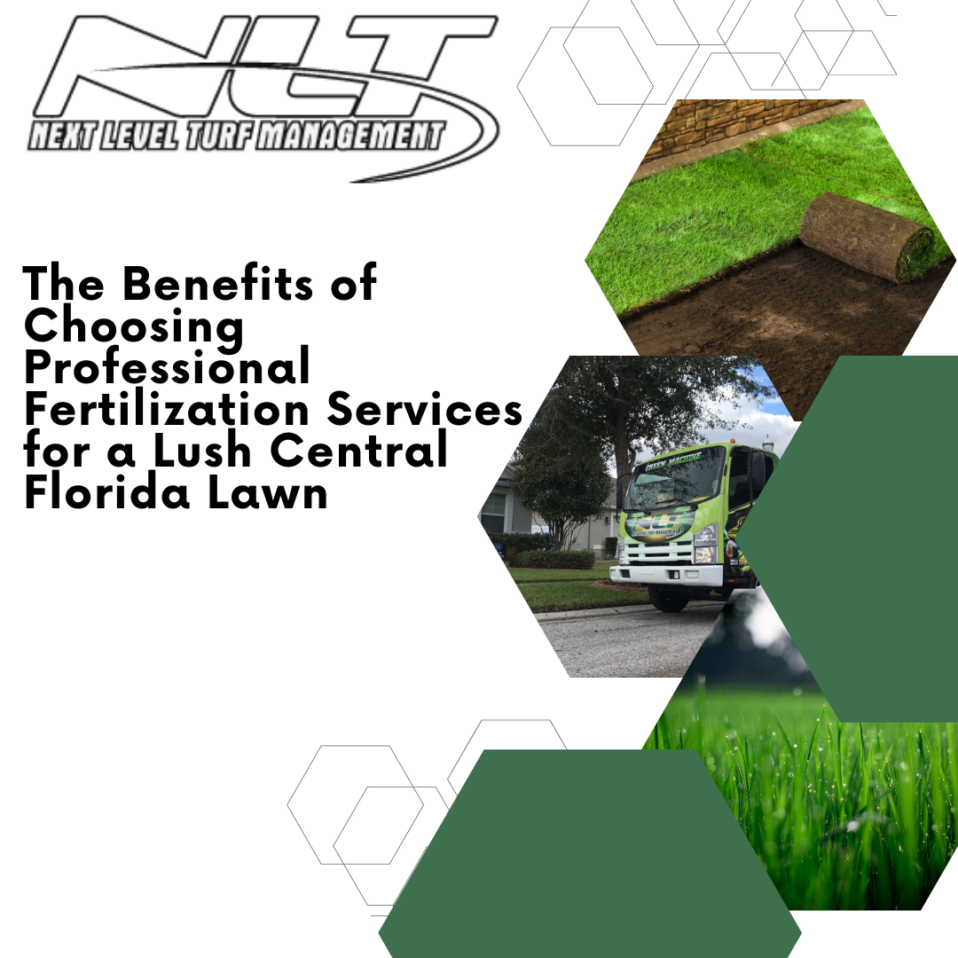 20
Feb
20
Feb
The Benefits of Choosing Professional Fertilization Services for a Lush Central Florida Lawn
There’s no denying the fact that a well-maintained lawn significantly enhances the aesthetic appeal of a property. In Central Florida, where the climate tends to be warm and humid, a lush green lawn requires special attention and care. That’s where professional fertilization services come into play. Next Level Turf, the premier turf management company in Central Florida, offers exceptional lawn care solutions, including fertilization services that ensure proper nutrient supplementation for a dense and healthy turf year-round. This article will explore the benefits of choosing professional fertilization services for your lawn in Central Florida. Whether you own a residential property or manage a commercial space, a lush lawn speaks volumes about the care and pride you invest in your property. The right type of fertilization is critical to achieving a vibrant, healthy, and thriving lawn, and this is best achieved through the expertise of professional service providers like Next Level Turf. In this article, we will delve into the advantages of working with a professional fertilization service to maintain a lush, green turf in the Central Florida region. Some of the noteworthy benefits of choosing professional fertilization services include access to experienced technicians, customized fertilization programs, and time and cost savings. Moreover, by trusting your lawn to the professionals, you are promoting environmental sustainability with eco-friendly practices, as well as ensuring that your lawn receives the timely care it needs throughout the year. Read on to explore the benefits of choosing professional fertilization services offered by Next Level Turf, Central Florida’s premier turf management company, and how their tailored solutions will help you achieve a lush, vibrant, and healthy lawn all year round. Expertise in Lawn Fertilization and Care One of the primary benefits of choosing professional fertilization services like Next Level Turf is the unparalleled industry expertise that their technicians bring to the table. These professionals are well-versed in Central Florida’s unique climate, soil conditions, and regional grass varieties. They possess the knowledge and skills needed to create a customized fertilization plan tailored to the specific needs of your lawn. Moreover, they possess an extensive understanding of the growth patterns, nutrient requirements, and potential problems that turf lawns face in this region. Working with these experts ensures that your lawn receives the best possible care, leading to a healthy and lush turf throughout the seasons. Customized Fertilization Programs A key advantage of partnering with a professional fertilization service like Next Level Turf is the ability to access personalized fertilization programs that suit the unique conditions of your lawn. A one-size-fits-all approach will not yield the desired results when it comes to lawn care in Central Florida. The experts at Next Level Turf analyze factors such as your lawn’s grass type, soil condition, water usage, and current nutrient balance to design an appropriate fertilization schedule. This customized approach ensures that your lawn gets the right nutrients at the right time and in the right quantities to maximize growth and overall health. Environmental Sustainability Eco-friendly practices are an essential aspect of modern lawn care, and this is another strong reason to choose […]
-
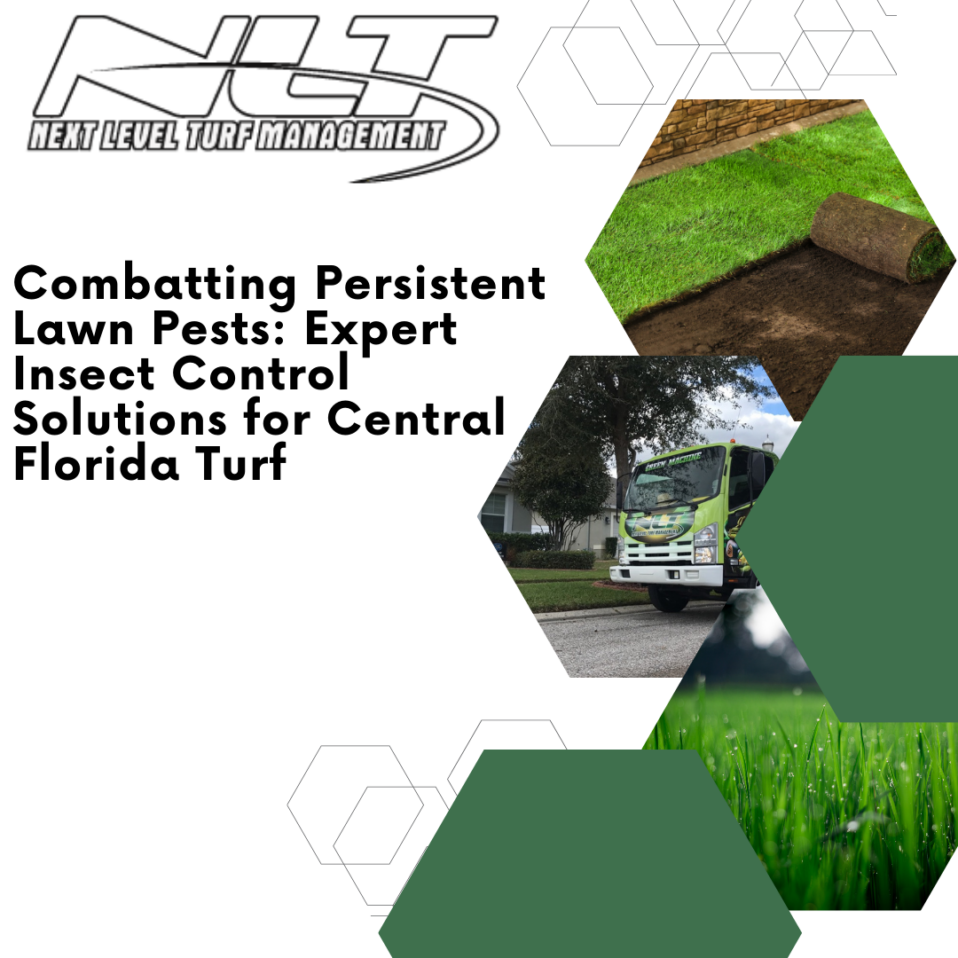 20
Feb
20
Feb
Combatting Persistent Lawn Pests: Expert Insect Control Solutions for Central Florida Turf
For homeowners in Central Florida, maintaining an attractive and healthy lawn is both a point of pride and a desire for the well-being of their property. However, due to the region’s unique climate, persistent lawn pests can pose a significant challenge to achieving a lush, thriving lawn. To address this issue, the expert team at Next Level Turf, Central Florida’s premier turf management company, offers comprehensive insect control solutions for residential lawns. Next Level Turf takes a thorough, customized approach to pest control, combining preventative strategies with targeted treatments to ensure an effective solution for your specific lawn conditions. Their experience in Central Florida’s unique pest control landscape is unparalleled, providing homeowners with the confidence that their lawn will be well protected against persistent insects and the damage they cause. In this article, we will explore the most common lawn pests affecting turfs in Central Florida, discuss the problems they create, and delve into the expert insect control solutions offered by Next Level Turf. By the end of this guide, you will gain valuable insights into identifying and dealing with lawn pests, as well as how partnering with a professional turf management company can go a long way in maintaining a vibrant, pest-free lawn. Discover how Next Level Turf’s expertise and customized approach can help you combat persistent lawn pests and enjoy a stunning, healthy, and resilient lawn. Common Lawn Pests in Central Florida Understanding the pests that can affect your Central Florida lawn is critical to combating the problems they create. The region is home to a wide array of insects, with some being harmless or even beneficial, while others can wreak havoc on the health and appearance of your turf. Some of the most concerning lawn pests in Central Florida include: Chinch Bugs: Chinch bugs are tiny insects that can cause visible damage to St. Augustine and other warm-season grasses. They feed on the sap of grass blades, injecting toxins as they feed, causing the lawn to turn yellow and eventually brown. Infestations can spread rapidly in hot weather, resulting in large dead patches in a matter of weeks. Sod Webworms: Sod webworms are the larval stage of a group of lawn moths. They feed on grass blades at night, clipping off sections and reducing turf density. When populations are high, they can cause extensive damage, leading to sparse patches and weakening the overall health of the lawn. Grubs: Grubs are the immature, worm-like larvae of several species of beetles, including the Southern masked chafer and the European chafer. They feed on the roots of grass, causing yellowing and wilting in the affected areas. High grub populations can lead to extensive root damage and even death of the turf, as well as creating an ideal environment for the proliferation of other pests and diseases. Mole Crickets: These pests are particularly troublesome in sandy or poorly maintained lawns. Mole crickets tunnel through the soil, causing the turf to become loose and irregularly raised. They also feed on grass roots and can weaken or kill the grass in affected areas. These pests are known to be active year-round, making vigilant […]
-
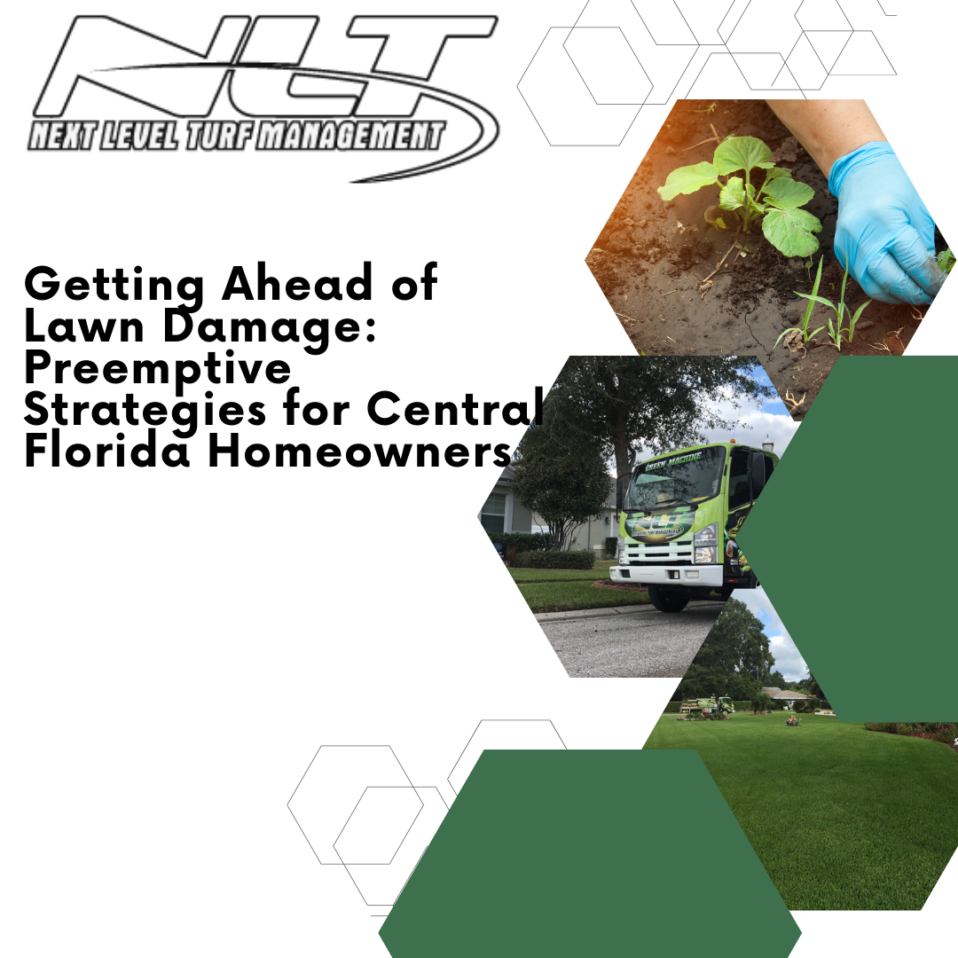 30
Jan
30
Jan
Getting Ahead of Lawn Damage: Preemptive Strategies for Central Florida Homeowners
Lawn Damage Prevention- If you call Central Florida home, you’re no stranger to the challenges that our tropical climate can pose to maintaining a vibrant, healthy lawn. The heat, the excess moisture, the myriad of pests—it’s a constant battle keeping that emerald carpet in pristine condition. But what if you could flip the script? What if, instead of always playing catch-up, you could preemptively tackle potential issues before they wreak havoc on your lawn? Sounds like a dream, right? Well, it’s not. With a bit of knowledge, some smart planning, and a dash of elbow grease, you can stay ahead of lawn damage. This blog is a homeowner’s guide to implementing preemptive strategies that can stop lawn damage in its tracks. You’ll find everything from choosing the right grass, to understanding the signs of potential problems, to implementing effective solutions. So, let’s roll up our sleeves and get our hands dirty, because your lawn is worth it. After all, it’s not just grass; it’s an extension of your home, a place for family fun, and a source of pride. It’s time to take control and be proactive about lawn care in Central Florida! Implementing Sustainable Lawn Care Practices in Central Florida Establishing and maintaining a healthy, resilient lawn in Central Florida requires commitment to eco-friendly and sustainable practices. Next Level Turf specializes in helping homeowners implement efficient and environmentally responsible lawn care strategies that benefit both their outdoor spaces and the planet. Here are several key aspects to consider: 1. Proper watering techniques: Overwatering can lead to shallow root systems, increased disease susceptibility, and wasted resources. Aim to provide your lawn with 1-1.5 inches of water per week by watering deeply and infrequently. Consider investing in a rain gauge or smart irrigation system to ensure optimal water usage. 2. Organic fertilization: Utilize organic, slow-release fertilizers that provide essential nutrients while reducing the potential for nutrient leaching and pollution of nearby water sources. Aim to apply fertilizer during the active growing season for your specific grass variety. 3. Regular mowing and cutting height: Mow your lawn regularly, maintaining a cutting height appropriate for your grass species (typically 2.5-3.5 inches). Avoid cutting more than one-third of the grass height during each mowing session, as this can stress the grass and increase the risk of damage. 4. Mulching and composting: By recycling grass clippings and leaves into mulch or compost, you can reduce waste and provide natural fertilizer for your lawn. This practice not only adds essential nutrients back into the soil but also helps with moisture retention. The Importance of Soil Testing and Adjustments for Central Florida Lawns – Lawn Damage Prevention Soil characteristics play a significant role in the health and vibrancy of your lawn. To create the ideal ecosystem for strong grass growth, we recommend conducting a soil test and implementing necessary soil amendments. Here’s how a soil test can benefit your lawn: 1. pH level evaluation: An essential aspect of soil health, the pH value should range from 6.0 to 7.0 for most turfgrass species in Central Florida. If your soil’s pH is outside this range, it may inhibit […]
-
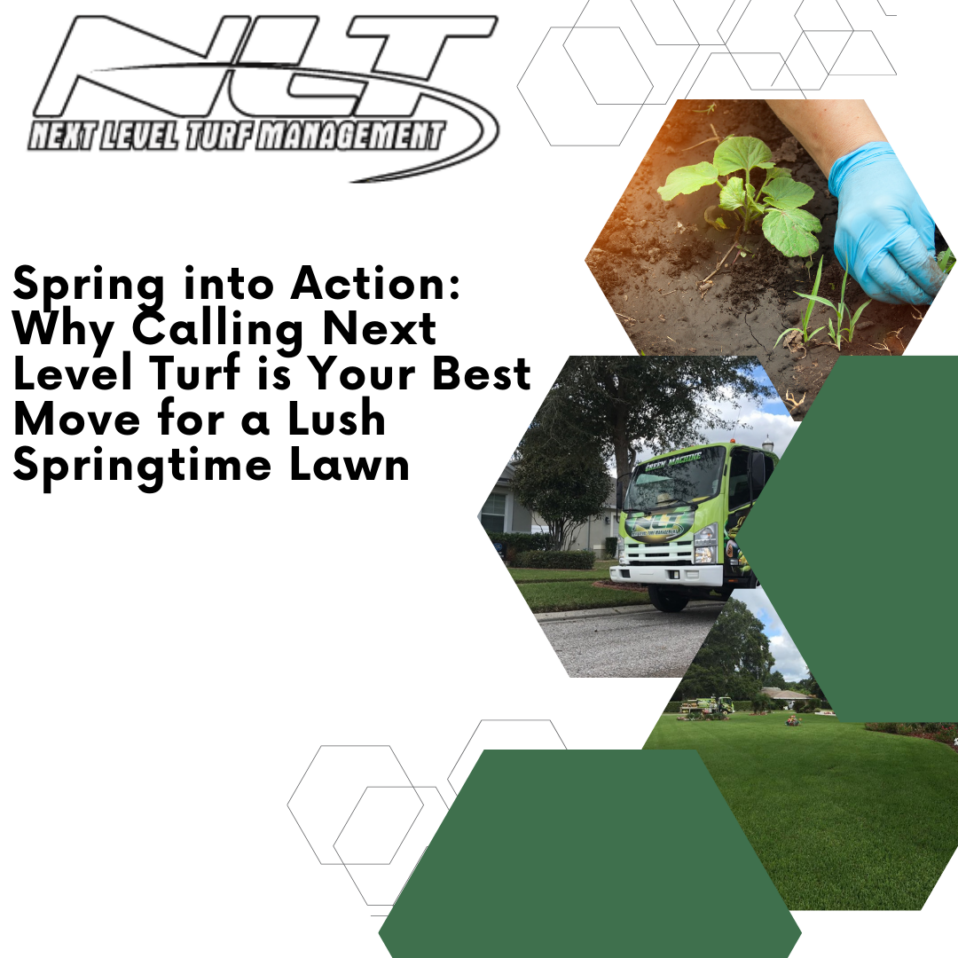 30
Jan
30
Jan
Spring into Action: Why Calling Next Level Turf is Your Best Move for a Lush Springtime Lawn
Springtime Lawn: The vibrant hues of spring eagerly await their turn to take center stage. Pops of green begin to sprout, signaling nature’s grand revival. And as you gaze out at your backyard, you can’t help but dream about a lush, verdant lawn that would make your neighbors green with envy. But the transition from a lawn in the winter to a springtime spectacle can be quite the challenge, requiring expertise and a fair bit of elbow grease. That’s where Next Level Turf comes into play! With our top-notch lawn care services, achieving a lush, healthy lawn is no longer a distant dream, but an achievable reality. Comprehensive Turf Management Services for Springtime Success Achieving a lush, healthy lawn in the spring requires a combination of expert care and tailored services that address the specific needs of your landscape. At Next Level Turf, we offer an extensive range of services designed to tackle the unique challenges of Central Florida’s climate and soil conditions. Here are some key components of our comprehensive turf management approach: 1. Fertilization: Providing your lawn with the right nutrients at the appropriate time is crucial for promoting healthy growth and vigor. Our team evaluates your soil’s nutrient levels and develops a customized fertilization plan to ensure optimal results, giving your lawn the best possible start to the new season. 2. Weed Control: Effective weed control is essential for maintaining both the health and appearance of your turf. Our experts assess the weed problems in your yard and implement targeted treatments that not only eliminate existing weeds but also prevent new ones from germinating. 3. Aeration: Soil compaction can be a major issue for many Central Florida lawns, limiting the flow of air, water, and nutrients to the turf’s roots. Our professional aeration services help alleviate this compaction, promoting stronger roots and a more resilient lawn. 4. Irrigation: Ensuring your lawn receives the right amount of water is crucial for its overall health and well-being. Our team will evaluate your existing irrigation system and recommend adjustments or improvements to maximize efficiency and prevent issues such as overwatering or underwatering. The Importance of Seasonal Lawn Care in Central Florida Understanding and addressing the unique seasonal challenges faced by your lawn is essential for achieving a lush, healthy landscape in Central Florida. As the weather warms up and growth resumes, taking a proactive approach to lawn care can yield significant dividends. Here’s why focusing on seasonal lawn care is crucial for springtime success: 1. Recovery from Winter Dormancy: As turfgrass gradually emerges from winter dormancy, it requires proper care and attention to regain its strength and vigor. Timely fertilization, aeration, and irrigation adjustments can ensure a smooth transition into the growing season, setting the stage for a thriving lawn in the months that follow. 2. Weed Prevention: Spring is a critical time for weed prevention, as many invasive species begin to germinate as temperatures rise. Implementing effective weed control strategies during this period is essential for keeping your lawn weed-free throughout the season. 3. Increasing Pest Activity: Warmer weather can also lead to increased pest activity, making it critical […]
-
 21
Dec
21
Dec
Tired of Weeds Taking Over? Let Us Restore Your Lawn’s Beauty!
Is your once lush, green lawn now looking more like a weed-infested wasteland? Are you at your wit’s end, trying to reclaim your yard from the clutches of nut sedge, crabgrass, and other unwelcome invaders? We totally get it. Nothing can be more frustrating than watching something you’ve worked so hard to cultivate become overrun with these pesky, persistent plants. But don’t throw in the towel just yet! We’re here to tell you that it’s not a lost cause. You don’t have to live with a lawn that’s more weeds than grass. We’ve got the solution to restore your lawn’s beauty, bringing it back to its former glory or perhaps even better. From identifying the types of weeds wrestling control of your yard, to tackling them with the most effective and eco-friendly methods, we’ve got it all covered. We believe that every lawn, no matter how overrun by weeds, has the potential to be a beautiful, green oasis. And we’re passionate about helping you achieve this. So, if you’re tired of constantly battling weeds and longing to see your lawn thrive, stick around. We’ll provide you with the knowledge, tools, and tips to reclaim your lawn and keep it looking its best. We’re ready to help you win the war on weeds and restore your lawn’s beauty. Your dream of a lush, vibrant lawn is still within reach. Let’s make it happen together! Understanding Common Central Florida Weeds To effectively combat weeds in your lawn, it’s essential to understand the types of weeds commonly found in Central Florida and their growth habits. This knowledge will enable you to adopt the most effective weed control strategies tailored to your specific lawn conditions. Some prevalent Central Florida weeds include: Crabgrass: One of the most common and challenging weeds to control, crabgrass is an aggressive, annual grass species that thrives in warm climates and can quickly spread if untreated. Dallis Grass: Dallis grass is a perennial grass native to South America. This weed is characterized by its thick, coarse blades that grow in clumps, and tall seed stalks that can reach up to five feet in height. Dallis grass thrives in sandy or clay soils with good drainage. It grows rapidly and can quickly overtake a lawn or garden if not managed properly. Dollarweed: Also known as pennywort, dollarweed is a perennial with round, shiny leaves and flowers that resemble small white umbrellas. This weed thrives in damp conditions, which are common in Central Florida. Nutsedge: Also referred to as nutgrass, nutsedge is a perennial weed with a grass-like appearance. It reproduces through underground tubers called nutlets, making it extremely difficult to control. Effective Methods for Weed Control Managing weeds in your lawn is a crucial task that requires a strategic and comprehensive approach. These methods can be combined to achieve optimal results and ensure your Central Florida lawn remains weed-free and beautiful: Pre-emergent herbicides: Applying pre-emergent herbicides strategically before weed seeds germinate can effectively prevent the growth and establishment of new weeds in your lawn. Timing is essential with pre-emergent herbicides, as they are most effective when temperatures are between 65 […]
-
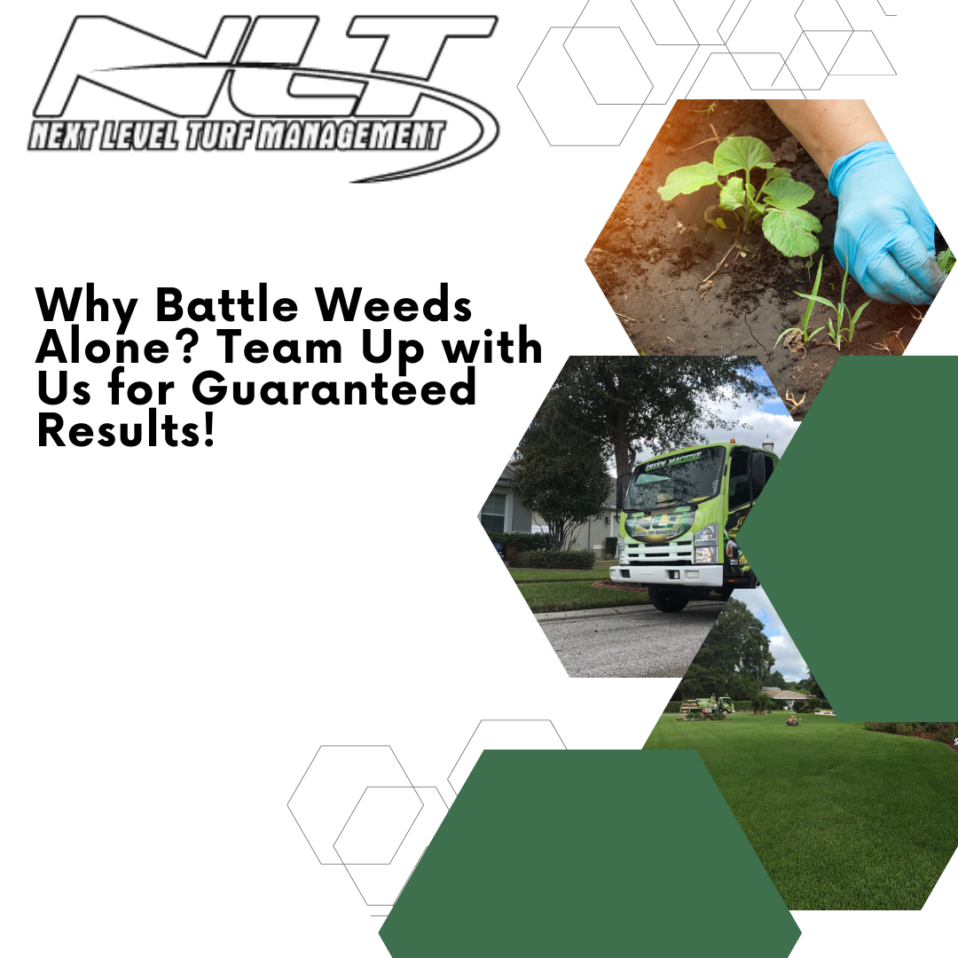 21
Dec
21
Dec
Why Battle Weeds Alone? Team Up with Us for Guaranteed Results!
Tired of battling those pesky weeds all by yourself? Exhausted from spending countless hours pulling out those stubborn green invaders only to see them sprout back up again? We totally understand your frustration. Weeding is a never-ending, back-breaking task that consumes your precious time and energy. But guess what? You don’t have to do it alone anymore! Imagine a weed-free garden without having to lift a finger. Sounds like a dream, right? Well, we’re here to turn that dream into a reality. We’re a team of weed control specialists dedicated to helping you reclaim your beautiful garden from the clutches of those relentless weeds. Partner with us for a hassle-free, effective solution to your weed problems. We’re not just about temporary fixes; we aim for lasting results. So, why battle weeds alone when you can team up with us? Your garden deserves the best, and we’re here to deliver just that. Enjoy the peace of mind knowing your garden is in the hands of professionals. Let’s join forces and say goodbye to stubborn weeds for good! Comprehensive Turf Management Services Offered by Next Level Turf At Next Level Turf, our team of experts is dedicated to providing comprehensive solutions for all your turf management needs. By offering a wide range of services tailored to address the unique challenges faced by Central Florida lawns, we ensure that your landscape remains healthy, vibrant, and weed-free. Weed Control: Our weed control program targets both broadleaf and grassy weeds, using eco-friendly methods. We employ pre-emergent and post-emergent herbicides, applying them strategically and ensuring your lawn remains safe and healthy throughout the treatment process. Lawn Fertilization: Proper fertilization is critical to maintaining a healthy turf that can fend off weeds and other stressors. Our team uses high-quality, slow-release fertilizers appropriate for your specific grass type and soil conditions. Pest Management: Lawns in Central Florida are often susceptible to pests such as chinch bugs, grubs, and mole crickets. Our integrated pest management approach focuses on reducing populations through targeted applications and promoting a healthy lawn ecosystem that can naturally resist pest invasions. Lawn Disease Treatment: Our specialists identify and address various lawn diseases, such as brown patch, dollar spot, and leaf spot, that compromise your turf’s health and provide an opportunity for weed growth. The Benefits of Partnering with a Professional Turf Management Company Teaming up with a professional turf management company like Next Level Turf offers numerous benefits, elevating your lawn’s health, appearance, and overall resilience. Expertise: Our team of professionals has extensive knowledge of Central Florida’s unique climate, soil conditions, and the challenges faced by local lawns. This experience enables us to craft customized solutions that effectively address weed issues and promote optimal lawn health. Time Savings: Proper lawn care and weed control can be time-consuming for the average homeowner. By partnering with Next Level Turf, you can save time and energy and focus on enjoying your beautiful landscape instead of struggling to maintain it. Environmentally Friendly Practices: Our commitment to eco-friendly methods means we use safe, environmentally responsible practices in every task we perform. From employing organic weed control methods to selecting […]
Recent Posts
-

Solving Drainage Problems with Expert Sod Replacement
Posted on December 10, 2024 -

Avoiding Overwatering: Irrigation Mistakes to Avoid
Posted on December 10, 2024 -

Revitalize Your Lawn: Late Summer Sod Installation Tips
Posted on October 30, 2024
-

The Advantages of Choosing Experts for a Healthy Lawn
Posted on April 8, 2024 -

Solving Drainage Problems with Expert Sod Replacement
Posted on December 10, 2024 -

Avoiding Overwatering: Irrigation Mistakes to Avoid
Posted on December 10, 2024

